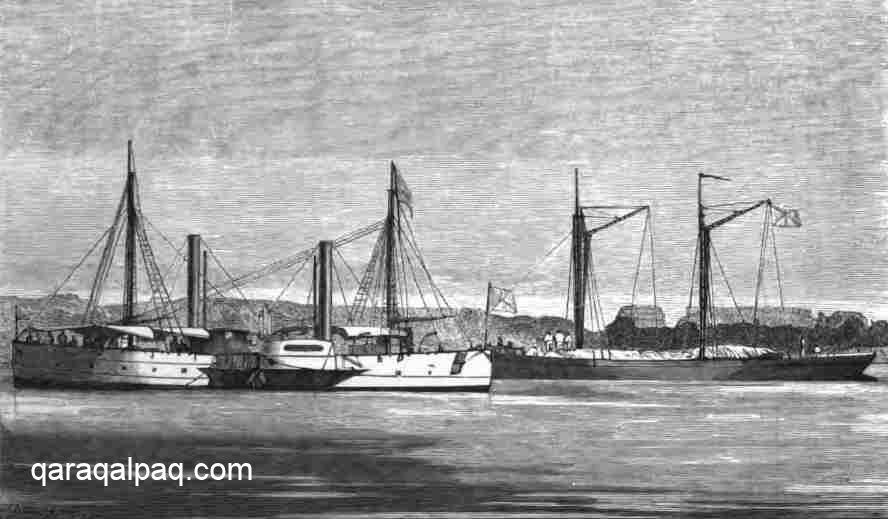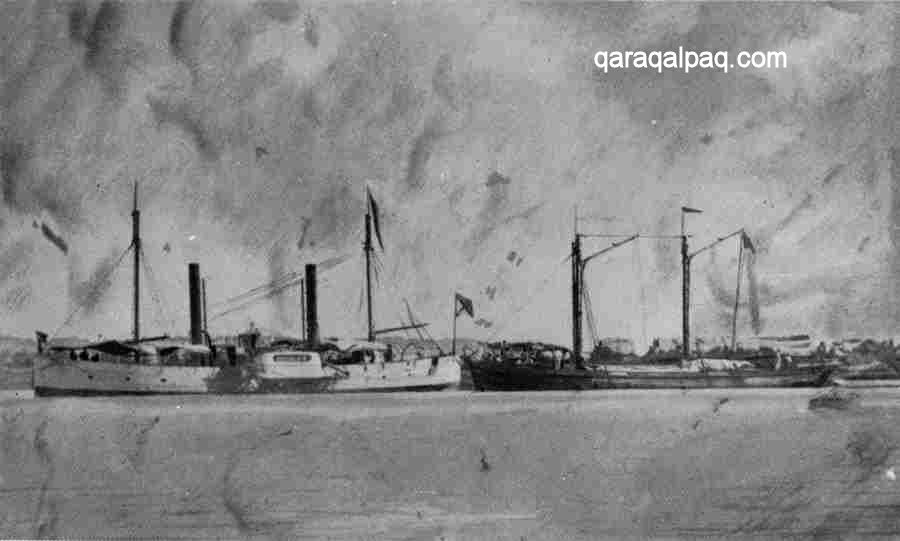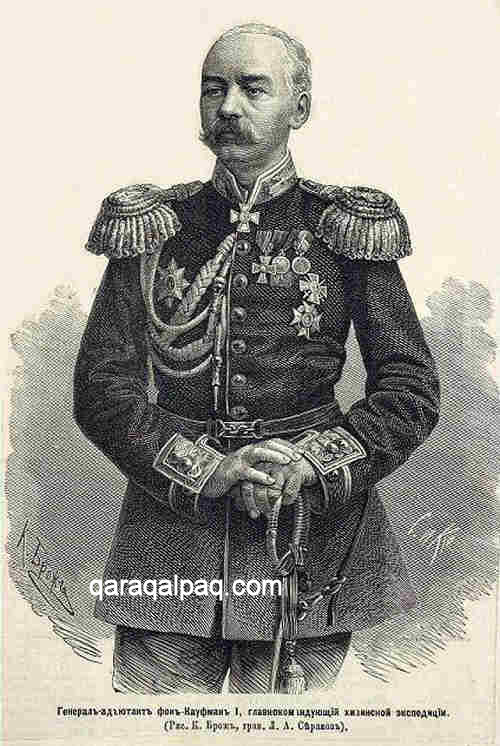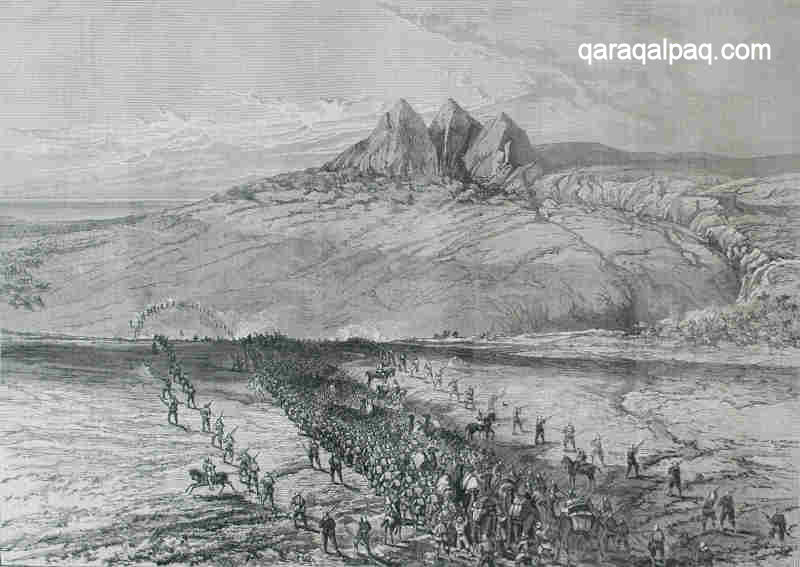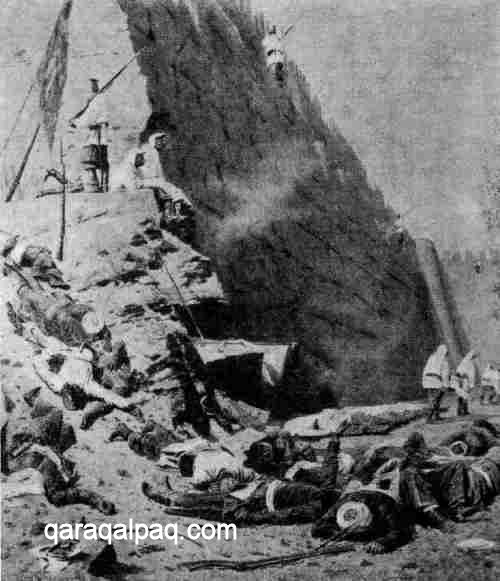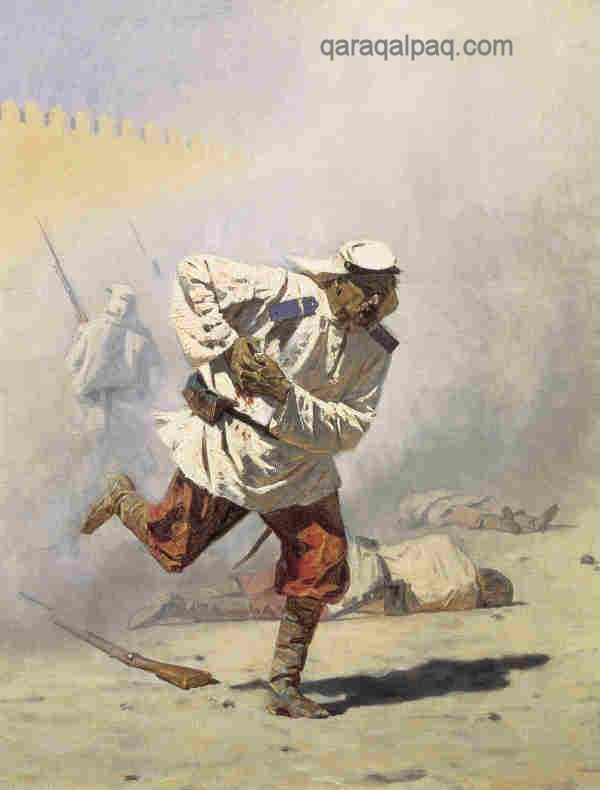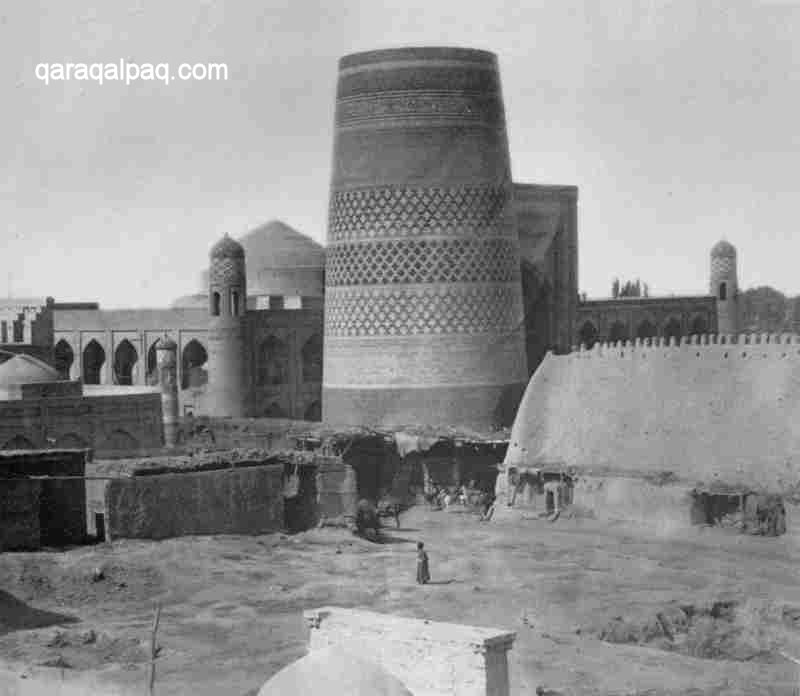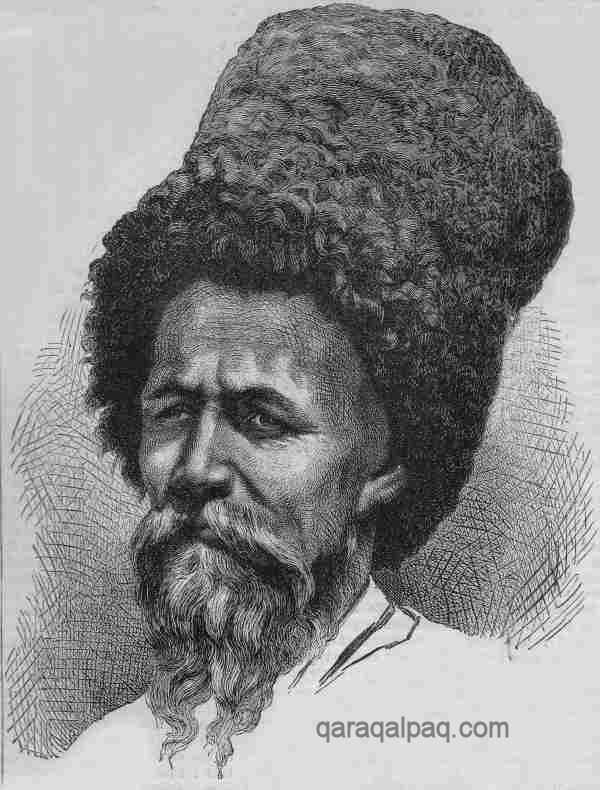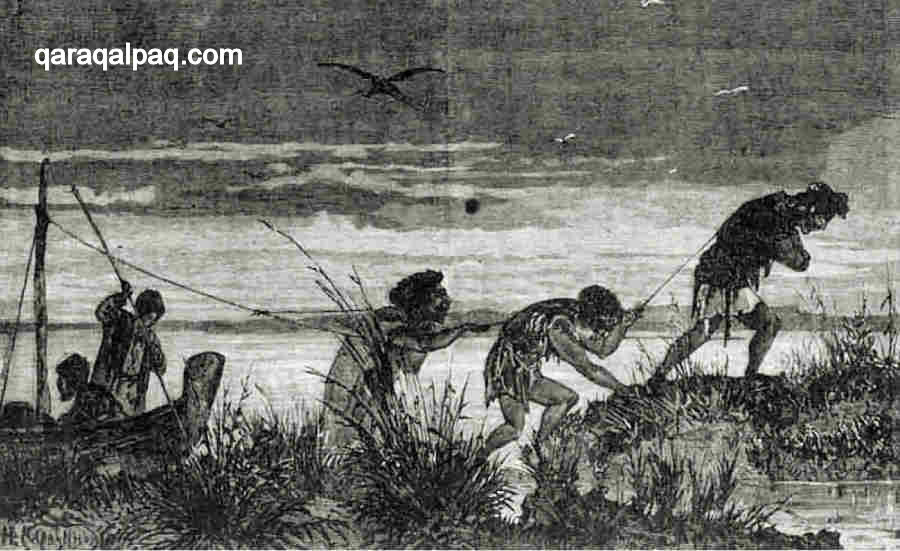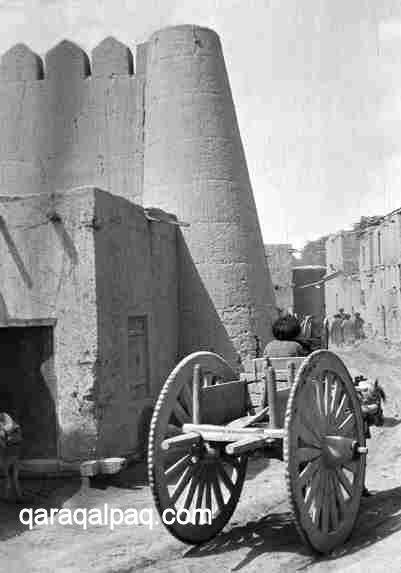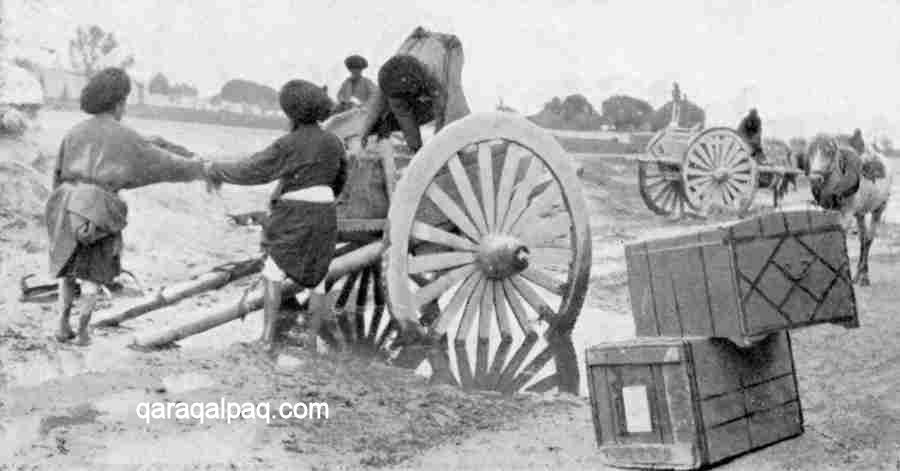|
Contents
Intervention by Russia
Russian Annexation
Russian Khorezm
Repression and Dissent
Prelude to Revolution
References
Russian troops entering Khiva through the Hazarasp gate.
From a drawing by N. N. Karazin published in the Illustrated London News, 22 November 1873.
Intervention by Russia
By now the British were well aware of Russian ambitions in Central Asia and of the possible risk to India. The Great Game was well under way with
British and Russian spies criss-crossing Central Asia to gather intelligence for their respective governments. The British sent Connolly to spy on
Khiva but his mission had to be aborted after robbers attacked him in the desert. "Bukhara" Burnes successfully reached Bukhara and Pottinger became
a hero after assisting Herat to overcome a siege by the Shah of Persia. The British were not quite so concerned about Persia gaining a foothold in
Afghanistan gunboat diplomacy was enough to warn the Persians off. Their real concern was Russia and in 1839 they decided to take control of
Afghanistan themselves, conquering Ghazni (ancient Ghazna) and establishing a garrison in Kabul. India was now protected by a formidable defensive
buttress.
Britain's increasingly aggressive stance had alarmed the Russians, who in any event had decided that the time was right to take Khiva. With the
approach of winter General Perovsky set out from Orenburg with a force of 5,000 men, 2,000 horses and 10,000 camels, under the guise of freeing the
Russian slaves. He was armed with 22 guns and a rocket battery. He had chosen this time of year to make sure that there would be sufficient water
for his men and animals, hoping to arrive in Khiva before the weather deteriorated badly. However 1839 turned out to have one of the earliest and most
severe winters in living memory. By January Perovsky was only half-way there, bogged down in snow and ice, losing men from frostbite and with
his camels dying at the alarming rate of 100 a day. On 1 February he gave the order to retreat but did not get back to Orenburg until May, his
progress and supplies being disrupted by the constant snowstorms and whirlwinds. He had lost 1,000 men and 8,500 camels and had not even fired a shot
in anger.
The British spy network had long ago passed news of the intended Russian mission back to London, and at the end of 1839 Captain Abbott had been sent on
a reconnaissance mission from Herat to Khiva, travelling via Merv. Abbott arrived in mid-winter with a message of friendship from the British Envoy at
Herat, along with modest gifts of firearms. He found Allah Quli Khan to be an amiable man, aged about 45, with a rather timid manner and a lack of
vigour. The Khan, fully aware of the Russian advance, was disappointed that Abbott had come without any offer of British military assistance. The Khan
was totally ignorant of Britain or its Empire, finding it hard to take a country with a female head of state seriously. It soon became clear to Abbott
that the Khivans had little concept of either Russian or British military power, or even of the general geography of Eurasia Abbott was amazed to see
the Khan refer to a local map on which Italy was located to the north of Britain and China was located to the north of Russia! After much questioning
and evasion Abbott discovered that the Russians had advanced from Orenburg to Emba and had then sent a detachment of troops forward to entrench
themselves to the north-west of the Aral Sea. Meanwhile the Khan had dispatched an army on horseback, ridiculously claimed to be 40,000 strong, up the
west coast of the Aral Sea, where they had encountered heavy snow. An advance party of Turkmen had attempted to seize the cattle from the advance post
of the Russians, only to have been spotted and picked off like flies by the Russian fusiliers. Meanwhile many members of the main Khivan army had been
mutilated by the intense cold and its commander had sought the Khan's permission to retreat to Qon'ırat.
Abbott argued that if Khiva was to seek British assistance it would first have to release all of the Russian citizens enslaved in Khorezm. However,
when the Khan asked for assurances that such a release would stop the Russian advance, Abbott was unable to offer anything in return. He had come to
Khiva on the spur of the moment, without even any credentials from the government of India. After some delay he finally departed empty-handed in late
March, travelling to Dashoguz, then across the Ustyurt to Novo Aleksandrovsk, up the Caspian and thence to Orenburg. Here he not only discovered that
the Russian invasion force had been recalled to Orenburg, but was introduced to, and entertained by, General Perovsky himself. Before leaving for
Moscow and Saint Petersburg, Captain Abbott also discovered that the Russians seemed to be making preparations for another assault on Khiva later that
year.
Meanwhile a young 28-year-old, Lieutenant Shakespeare, had been sent to Khiva to check on Abbott's progress, only to arrive after his departure.
Although the Khan was now in good spirits, having heard news of the Russian disaster, he was also concerned about what Russia would do next. By now
the local population were aware of the Russian advance on Khiva, news that the Khan turned to his advantage by spreading propaganda that the invaders
had actually been slaughtered by his own forces just north of Qon'ırat.
Lieutenant Shakespeare struck up a good relationship with the Khan and convinced him that the Russians would not give up because of Perovsky's failure
and would eventually send another expedition. His best defence was to release the Russian slaves and to issue orders forbidding the further capture
or purchase of Russians. Although the Khan was reluctant to act, the British officer finally persuaded him to release 416 Russian slaves into his care,
who Shakespeare subsequently escorted to General Perovsky in Orenburg much to the chagrin of Tsar Nicholas I, who had just lost one of his main
excuses for a further invasion.
The Tsar sent envoys to Khiva in 1841 and 1842, and a Colonel Danilevskiy finally succeeded in securing the first treaty between the two countries. The
Khivans promised not to engage in hostilities with Russia, or to commit acts of robbery or piracy - promises that were not worth the paper they were
printed on. However before Danilevskiy could leave Khiva, Allah Quli Khan died and was succeeded by his son, Rahim Quli (1842-46), who ruled for just
a few years.
Danilevskiy recorded various statistics on the province, which indicate its small size and dilapidated state at that time. The population of Khiva was
about 4,000, virtually all Sarts, while the population of (New) Urgench was about 2,000, composed mainly of Sarts and a few Uzbeks. The rectangular
wall around the latter city was in ruins with only the corner towers and two collapsed stone gates remaining. The town had 300 houses, 15 mosques, 2
medressehs and 320 shops. Shahabad had a house for the Khan with a garden, one mosque, up to 100 shops and some private houses. The walls were in
ruins in many places. Gurlen had no wall at all and was densely built with 60 shops and three main mosques. The town of Kath had a rectangular wall,
now in ruins, a single gate from the east, 50 houses and 40 shops, and no population the town was deserted.
The major reconstruction of Khiva that had begun under Muhammad Rahim had continued under Allah Quli Khan. He built the majolica-tiled 163-room
Tash Hauli Palace in 1830-32 using the best craftsmen available in Khorezm and the Allah Quli Khan Caravanserai and Bazaar nearby, although it is likely
that Persian slaves did all of the hard work. The interior of the Kunya Ark was refurbished with a new mosque, and work began on the Allah Quli Khan
and several other Medressehs. The defences of the Ichan qala were improved with the western Ata Darvaza (Master Gate) and the southern Tash Darvaza
(Stone Gate), being rebuilt. The expansion of the city can be gauged from the need to build a new 6½-kilometre-long outer rampart around the
outskirts of the town - the Dishan qala entered by means of ten gates. Its purpose was to defend Khiva against Yomut Turkmen raids. Residents of the
town were forced to work unpaid for 12 days a year to assist in its completion.
Allah Quli Khan was also responsible for building a brick palace at Dashoguz with a royal garden, close to the stone-encircled pond from which the town
derived its name. Its purpose was to provide him with an overnight stopping place. Dashoguz was a walled town with three gates: the west, the south
and the palace gate. It contained a mud-brick fort. Surrounded by rich farmland it was already a large residential centre with six mosques, many shops
and workshops and a caravanserai.
The rapid development of Khiva at this time is evident from a secret map drawn by a Russian topographer, G. Zelenin, who arrived in Khiva with one of
the delegations of ambassadors in 1841. Given Khivan suspicions about future Russian intentions, Zelenin had to produce his map undercover. Had he been
caught his party would never have survived to tell the tale. It is said that he purchased two melons from the bazaar and wandered the town asking people
about the names of the streets and lanes and the mosques and medressehs, secretly inscribing this information on the melon skins so that it could be
transferred to his map in the evenings. The map showed the outer city wall was pear-shaped with the stem pointing westwards. The inner city was
rectangular, 600 metres from east to west and 400 metres from north to south. The city then had 17 mosques, 22 lanes and 260 merchants' stalls along
with medressehs, bazaars and caravanserais. Gardens, country estates, irrigation networks, fields and roads extended beyond the outer city walls.
Despite the major setback of Perovsky's mission, the Russian encirclement of Central Asia was gradually progressing. The earlier Russian forts along
the eastern Caspian coast had been quickly abandoned after the demise of Bekovich's mission, so new garrisons were needed in the region. The
construction of Fort Novo Aleksandrovsk had begun in Tsarevitch Bay on the eastern Caspian shore in 1833 and was followed by the construction of a chain
of forts to the south-west of the Aral Sea, giving Russian forces increasing control of the Ustyurt. Fort Aleksandrovsk was later relocated to the
western tip of the Mangishlaq peninsula. In 1847 the Russians built Fort Raim, a small hilltop fortification close to the mouth of the Syr Darya, which
became the base for the new Aral Flotilla, established to undertake research work on the Aral Sea and its two river deltas.
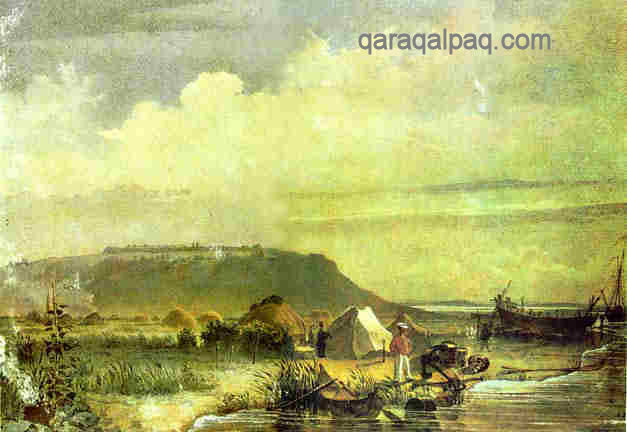
|
View of hilltop Fort Raim from the shipyard on the Syr Darya.
A watercolour painted by Taras Shevchenko in the summer of 1848.
From there Forts Number 1, 2 and 3 were built upstream along the Syr Darya over the next few years: Fort Number 1 was built at present-day Qazaly
in 1851, Fort Number 2 at Joudali in 1852 and Fort Number 3 at what is now Qizil Orda in 1853. However the initial location of Fort Raim (which
subsequently became Aralsk) turned out to be an unsuitable one at that time, being subject to frequent flooding. In 1855 its garrison was moved to
an enlarged fort built on the site of Fort Number 1, which subsequently became known as Fort Kazalinsk. Fort Number 3 eventually became known as Fort
Perovsky. Though sufficient for Central Asian requirements, these forts were fairly primitive by Western standards, with earthen outer walls and
ditches defended with light artillery, enclosing barracks, workshops and housing for senior officers.
The initial fleet of the Aral Flotilla consisted of two twin-masted schooners, the warship "Nikolay" and the merchant ship "Mikhail", both constructed
in Orenburg in 1847. The first was designed for surveying and the second for establishing a fishery, but neither were capable of safely venturing far
onto the Aral Sea with its perilous shallows, and they became restricted to surveying the island of Qosaral in the mouth of the Syr Darya estuary and
the other islands down the eastern coast of the Aral Sea. Soon a somewhat larger schooner, the "Konstantin", was built in Orenburg and was used by
Lieutenant Aleksey Butakov to undertake the first complete survey of the Aral Sea in 1848 and 1849. The largest island in the centre of the Aral Sea
was discovered in September 1848 and was named Nicholas 1st Island, in honour of the Tsar. Nasledinik, or Heir Island was discovered seven miles to
the north-west of Nicholas 1st Island, along with Konstantin Island to its south. Butakov's "Survey of the Sea of Aral" provided the first
scientifically produced map of the Aral Sea and its environs, which was subsequently copied by Augustus Petermann in London for the Journal of the
Royal Geographic Society in 1853, and was then reproduced commercially as a coloured lithograph.
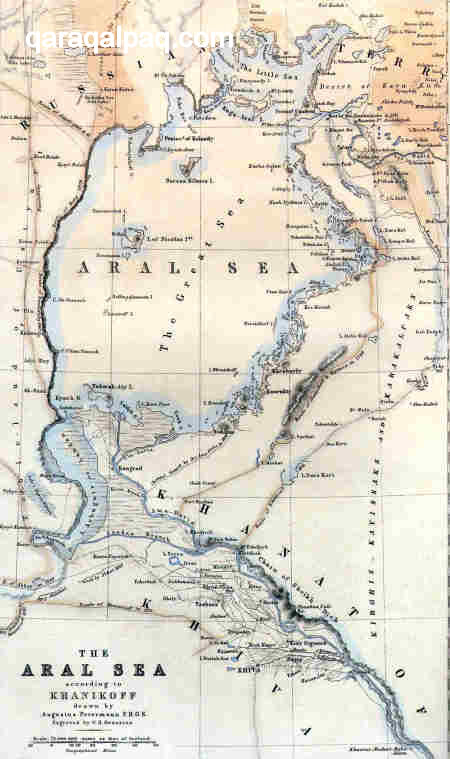
|
Lithographed map of the Aral Sea based on the first Russian survey in 1848-49.
Copied by Augustus Petermann for the Journal of the Royal Geographic Society in 1853 and then reproduced commercially.
In 1850 the Russians ordered the construction of two new boats from a Swedish shipyard the "Perovsky", a forty horsepower paddle-wheel steamboat,
and the "Obrutchef", a twelve horsepower propeller-driven iron barque. The "Perovsky" was launched at Fort Raim in 1853, two years ahead of the
"Obrutchef", and was armed with three nine-pound guns. However it proved to be too large for navigating the more difficult parts of the Syr Darya
and was continually running aground. In a whole season it could only make three round trips between Fort Kazalinsk and Fort Perovsky. Both steam
boats required huge quantities of saxaul to fire their boilers and on one occasion 180 tons of anthracite was especially transported overland from the
River Don at enormous cost!
Although something of an aside, there is a very interesting human story associated with the early Aral Flotilla. In 1847 a Ukrainian poet and painter,
Taras Shevchenko, was arrested in Saint Petersburg for sedition by the Tsar's secret police. Although Shevchenko had been born into serfdom, he was
fortunate to have been contracted to a master painter in Saint Petersburg while still a teenager, and there he received a rigorous training in drawing
and art. Clearly a talented all-rounder, Shevchenko was not only a gifted painter but also a prolific poet, and soon attracted a group of admirers and
supporters who eventually bought him his freedom when he was 24-years-old. Seven years later he moved to Kiev and became associated with a society of
liberals who wanted an end to feudalism, and independence for the Ukraine today he would be regarded as a human rights activist. However the real
cause of his downfall was not his politics but his satirical poetry none other than Tsar Nicholas himself regarded Shevchenko's poems as a personal
insult and condemned the poet to military service for life, without promotion, expressly prohibiting his engagement in any further writing or drawing -
a terrible indictment for such a brilliant artist. He was sent on a forced march from Saint Petersburg to Orenburg where, by good fortune, General
Perovsky assigned him to the Academician Karl Ernst von Baer, a Baltic-German naturalist. Von Baer was a rising star in the Academy of Sciences in
Saint Petersburg and was becoming increasingly influential in the exploration of the new Russian territories, specializing in lakes and fisheries. As
such he had been selected to undertake the first scientific expedition of the Aral Sea on the newly built "Konstantin", under the command of Lieutenant
Butakov.

|
The cliffs, known as the tchink, bordering the western side of the Aral Sea.
A watercolour by Taras Shevchenko, painted in 1848-49.
Although officially no more than a common sailor, Shevchenko was tasked with sketching the various landscapes around the coast of the Aral Sea, including
the local Qazaq nomads, and was effectively treated as an equal by the other members of the expedition. After a voyage of over eighteen months he
returned with his album of drawings to General Perovsky at Orenburg, who was impressed with his work and sent a positive report to Saint Petersburg
hoping to obtain some amelioration in Shevchenko's punishment. The response was quick and severe. Perovsky received a sharp reprimand and Shevchenko's
punishment was increased to imprisonment. He was sent to one of the worst penal settlements, the remote fortress of Novopetrovsk, where he spent six
terrible years of mental and physical torment. Yet even here he managed to write and draw and, thanks to the efforts of his supporters in Saint
Petersburg, was finally released in 1857 following the death of Tsar Nicholas and the succession of the more liberal Tsar Aleksandr II. Today
Shevchenko is regarded not only as the National Poet of the Ukraine, but also as an important voice of freedom and independence by the formerly oppressed
peoples of Eastern Europe. Fortunately for us many of his simple and atmospheric sketches were preserved along with much of his poetry, some of it
written at the Russian fort on the island of Qosaral in 1848 and 1849. His lovely paintings give us our earliest visual impressions of the appearance
of the Aral Sea in the middle of the 19th century.
The construction boom in Khiva continued under Muhammad Amin Khan (1846-55) who decided to leave his mark on the city by building the tallest minaret
in Central Asia 70 metres tall. But he started too late and the minaret was only partially built when he died. Thus, by the hand of fate, his memorial
became not the tallest but one of the shorter minarets in Central Asia the Kalta Minar perhaps one of the most memorable buildings in the city. Like
his predecessors, Muhammad Amin continued the tradition of raiding Khurasan, Bukhara and the neighbouring Turkmen tribes, all paid for by taxing the
Sarts and Qaraqalpaqs. He eliminated the threat from the local Yomut Turkmen by building dykes to divert the flow of the Darya Lyk, forcing them to
relocate to the Balkan Mountains. After six campaigns he finally subjugated the Saryk Turkmen at Merv and then led three bloody campaigns against the
Tekke between the Merv and Akhal oases, with help from the Yomut. To keep the Turkmen in check a garrison was established composed of Uzbeks and Yomuts,
but the local chieftains argued and the Yomut leader returned to Khiva, where the Khan had him thrown from the top of a high tower. This alienated the
Yomut who then formed a secret alliance with the Tekke! When Muhammad Amin next set out against the Turkmen in 1855, his army suffered a crushing defeat
at the hands of Tekke Turkmen, somewhere in the region of Merv or Saraqs, and the Khan was decapitated.
This triggered an uprising of the Yomut Turkmen in Khorezm, and Muhammad Amin's son Abdullah Khan faced challenges to his position both from his great-
uncle and from princes supported by the Yomut. Within five months he was killed in a skirmish with rebellious Yomuts and was succeeded by his younger
brother, Qutlugh Murad.
The Yomuts sued for peace and offered to release the Khan's cousin, whom they had captured in battle and had proclaimed Khan. Qutlugh Murad accepted
the offer, not realising that it was a plot. On the appointed day the Yomut appeared in Khiva with a force of supposedly 12,000 men (surely a huge
exaggeration) and as the Khan received and embraced his cousin he was treacherously stabbed to death. News of the incident was broadcast from the walls
of the citadel, and the incensed population rose up and massacred all of the Yomuts within the city walls. It was said that the streets ran with blood
and that it took six days to dispose of all of the bodies.
With Muhammad Amin's only two sons now dead, the crown was offered to one of his uncles, the one who had challenged Abdullah Khan. But the uncle was an
opium addict, incapable of fulfilling the role, and he abdicated in favour of his younger brother, Sayyid Muhammad Khan (1856-1864).
It was a time of crisis for Khorezm the civil war between the Uzbeks and Turkmen had devastated Khiva and the surrounding regions, and the wives and
children of the warring factions had been taken into slavery. The instability had provided an opportunity for the Qaraqalpaqs in Khorezm to rebel, with
the Qon'ırat and On To'rt Urıw tribes uniting and encouraging the Qazaqs and Uzbeks from northern Khorezm to join their cause. When the insurgents appealed
to the Qazaqs along the Syr Darya, the new Khan realised he needed to take drastic action and he negotiated a truce and alliance with the Turkmen
leaders. The rebellious Qaraqalpaq villages were routed and at a major battle near Xojeli, Sayyid Muhammad managed to defeat the combined insurgent
forces, finishing off the survivors after a three-month siege close to the Aral coast. The local population were in a desperate condition, suffering
poverty, exhaustion, huge price inflation, unreasonable taxation, instability and repression and in 1857 there was a major famine in the countryside
followed by a cholera epidemic. Many Qaraqalpaqs fled the Khanate to seek refuge in Bukhara, the Syr Darya and the Russian territories to the north-west.
Appeals to the local authorities in Orenburg for protection received no response.
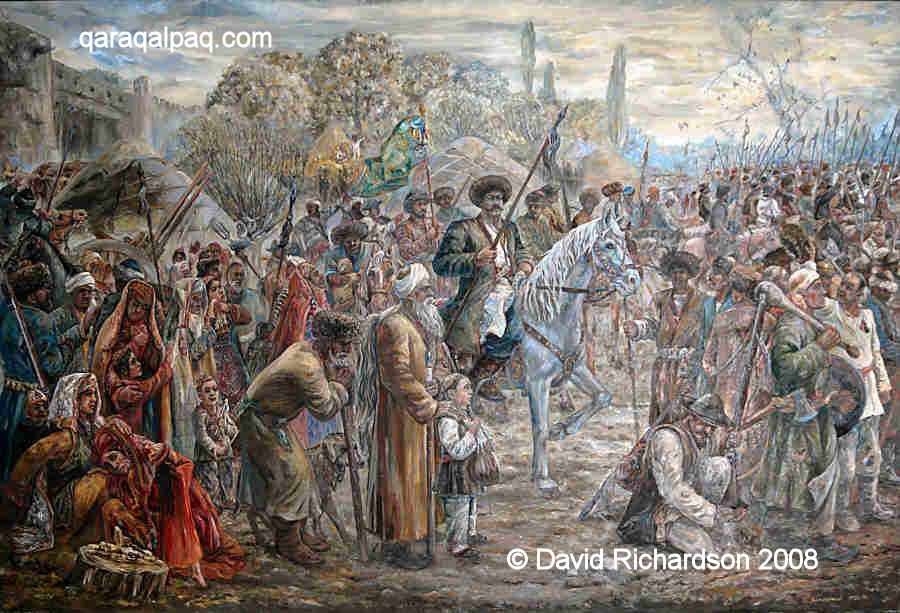
|
Ernazar Alako'z, nicknamed "big eyes", the leader of the 1856 Qaraqalpaq uprising.
Painted by Barlıqbay Aytmuratov in 1988-91. From the collection of the Regional Studies Museum, No'kis.
However the Russians did intervene in 1858, but for a different purpose. Having recently suffered defeat in the Crimean War, Russia was seeking to
increase its influence in Asia at the expense of the British. The new Tsar, Aleksandr II, had dispatched a mission to Khiva and Bukhara under the
leadership of the young Russian aristocrat N. P. Ignatyev, aimed at cementing friendships, increasing trade, surveying the geography and gaining
navigation rights for Russian ships on the Amu Darya. The embassy travelled overland from Orenburg, crossing the Ustyurt to reach the western shore
of the Aral Sea. They had planned to rendevous with the Aral Flotilla in Chernyshevskiy Bay and to then sail as close to Khiva as possible, using the
pretext of delivering lavish gifts to the Khan including a huge organ that had been transported across the steppes from Orenburg! However Captain
Butakov had become completely lost along the marshy shoreline of the Aral Sea and only reached Qon'ırat after the mission had departed by native boat
for Khiva. Nevertheless the paddle steamboat "Perovsky" along with its two attendant barges brought in vital supplies for Ignatyev and offered refuge
in the event of trouble. However its arrival caused alarm within the Khanate and the Khan refused permission for it to sail beyond Qon'ırat,
preventing a scientific survey of the lower Amu Darya.
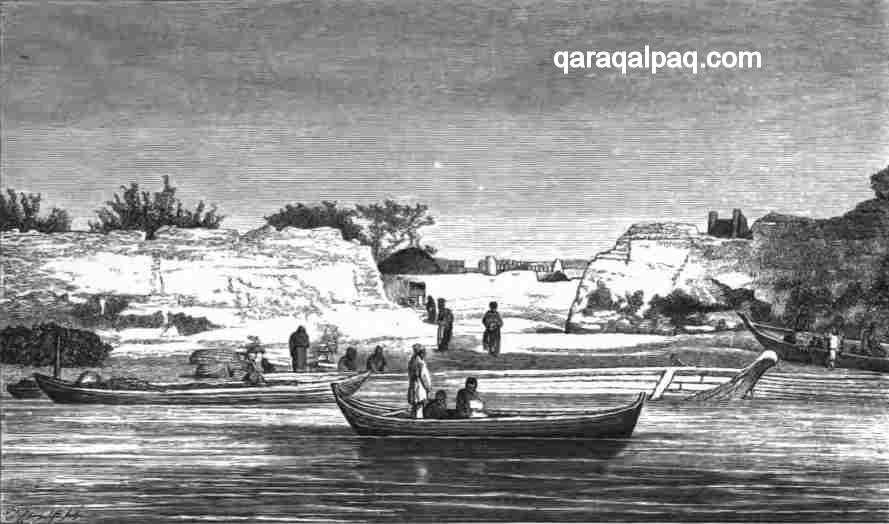
|
Part of the city of Qon'ırat from the Amu Darya.
Reproduced from Kühlewein's 1858 account of the Russian diplomatic mission.
An etching of the SS "Perovsky" and a barge moored opposite Qon'ırat.
Also from Kühlewein's 1858 account and remarkably similar to the photograph shown below.
Thanks to Kühlewein, the secretary to the mission, we have an account of the state of the left bank Qaraqalpaq territory that the
embassy passed through on its way to Khiva, devastated by the Turkmen forces of the Khan during the recent civil war:
"Almost all the villages and towns were in a deplorable condition, presenting ample evidence of the devastations of the Turkmen. In the ruined "auls"
or camps of the Karakalpaks, we only found old people and infants; the whole of the adult population had been carried away to Khiva, and across the
Persian frontier, to be sold as slaves. The towns of Kipchak on the left bank of the Amu-Daria, and Hodjeil, had met with a similar fate."
Ignatyev spent six weeks in Khiva and found Sayyid Muhammad Khan extremely nervous. The Khan was highly suspicious of the Russian's motives, worried about
the presence of an armed steam-driven naval boat and alarmed by the obvious mapping of his territories. Reading between the lines, one suspects that the
Khan might have come close to having the embassy massacred, but probably decided that he had enough enemies already without adding Russia to the list.
Ignatyev's group spent a very tense time in Khiva, being kept under armed guard at all times. The local residents cursed them and made threatening
gestures and they were deliberately kept awake at night by loud drums and music.
The SS "Perovsky" and a barge moored below the walls of Qon'ırat.
Photographed in July 1858 by A. S. Murenko, a subaltern attached to Ignatyev's diplomatic mission.
Sayyid Muhammad clearly trusted none of his officials, had not the faintest idea of how to deal with a diplomatic mission, and was afraid of being
assassinated like his predecessor. After numerous rounds of fruitless talks Ignatyev decided to wind-up his mission, but late at night prior to his
departure he was summoned for one last audience with the Khan. Aware of the personal danger, yet determined to show the Khan that he was not afraid,
Ignatiev dressed in full uniform and organized an accompanying detachment of his roughest and toughest Cossack guards, each armed with two loaded
revolvers. As he approached the gates of the Palace, a bonfire illuminated two enormous stakes on which two of the Khan's prisoners had recently been
impaled. The meeting with the Khan was sharp and acrimonious and the ambassador withdrew with his Cossack guards holding back the Khan's bodyguards
with drawn revolvers. It was therefore with considerable relief that Ignatyev departed for Bukhara, even though no agreement had been reached during
his mission. This expedition clearly demonstrated to the Russians that diplomacy alone was not enough to establish a foothold in the Khanate.
After the Russian Flotilla had departed the Khan arranged for the leaders of the northern insurgents to be killed. Qon'ırat was soon back under
Khivan control.
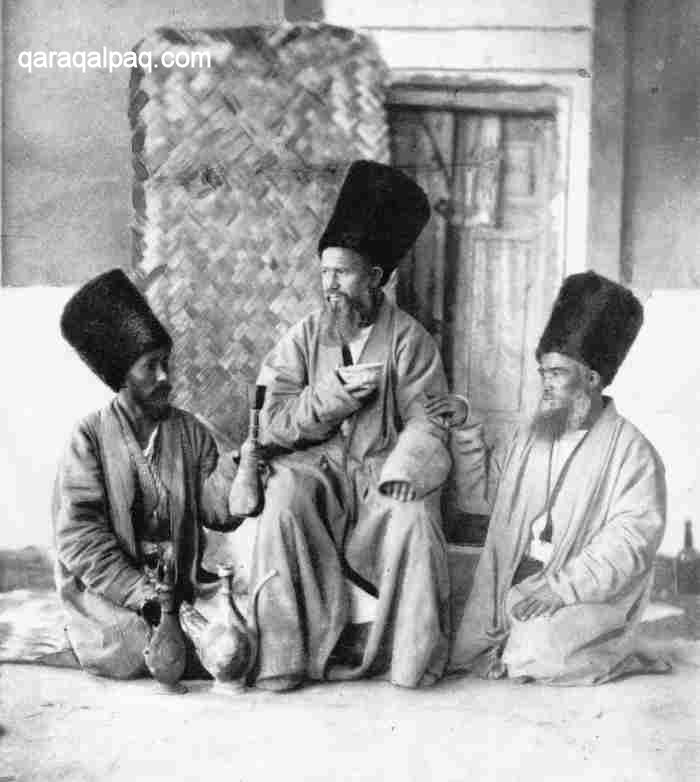
|
Three Khivans drinking tea in the courtyard of their home.
Photographed by A. S. Murenko in 1858.
The Hungarian professor of Oriental languages, Arminius Vambery visited Khorezm in 1863, thinly disguised as a Muslim Dervish from the Holy Land. Had
his disguise been uncovered he would at best have been enslaved as a Russian spy or at worst tortured and killed. Fortunately his audience with Sayyid
Muhammad Khan was uneventful and by now the Khan looked decrepit, having deep-set eyes, a chin thinly covered with hair, white lips and a trembling voice.
Yet Vambery knew he was a cruel and sick tyrant, daily disfiguring and executing his subjects often for minor transgressions. Vambery recorded that
there were many ha'wli farmsteads in the environs of Khiva, shaded by poplar trees and surrounded by meadows and rich fields. From a distance
the domes and minarets of the city "made a tolerably favourable impression" but its interior was even worse than a Persian city of the very lowest rank.
The bulk of the city consisted of a ten-foot high mud wall surrounding three or four thousand randomly arranged mud houses with uneven unwashed walls.
The bazaars were disappointing but there was a covered market, or Tim, with 120 shops selling cotton, linen, hardware, bread, groceries, soap and candles,
along with a caravanserai and customs post, which also served as the slave market. There were of course the monumental buildings within the Ichan qala,
but Vambery listed only four mosques of any antiquity or artistic construction, including the Pakhlavan Mosque and the Juma (or Friday) mosque, the
latter used by the Khan on a Friday. Only five medressehs had courts that could be classified as clean.
During his sojourn Vambery managed to travel down the Amu Darya to Qon'ırat and back and was astonished at the great fertility of the countryside
along the banks of the river, which he thought superior to anything he had hitherto seen in Asia. With the exception of the desert region around the
Sultan Uvays Dag, the land was well-cultivated and peopled, but in the delta where the Qaraqalpaqs lived the riverbank was covered with "primeval forest":
"In the less thickly-wooded parts graze numberless herds of cattle, the property of the Karakalpaks, who find abundance of game in the forests, but
sometimes suffer greatly from the numerous wild beasts, especially the panthers [sic], tigers and lions [sic], which infest the district."
Vambery observed that the main crops grown in the Khiva Khanate were wheat, rice, low-grade Qaraqalpaq barley used for horse feed, jugara, and millet,
along with peas, beans and lentils. The best fruits were melons, apples and sweet grapes. The region produced the best quality cotton of all of the
Khanates, as well as qendır or hemp, grown for low-quality linen, with a little silk grown in Khiva and Hazarasp. The Qaraqalpaqs were
said to raise the finest cattle.
In fact Russia was increasingly in need of Khorezmian cotton at this time as a result of the world shortage brought about by the American Civil War. More and more
land was turned over to cotton production during the early 1860s to satisfy this demand.
Turkmen insurrections continued until 1867, at which point the Khanate lost control over the Turkmen tribes in the south. During these uprisings large
portions of the lands irrigated earlier in the century became devastated and abandoned.
Russian Annexation
By now the British response to Russian expansion in Central Asia had become more subdued. Although Britain had defeated Russia in the Crimea, she had
faced several setbacks of her own. Afghan resistance had led to the massacre in the Khyber Pass and a British withdrawal from central Afghanistan, there
had been a major army mutiny in India, and Russia had outmanoeuvred Britain and France by concluding a treaty with China. The Russians now had 300
steamships on the Caspian, a railway from Saint Petersburg to the Volga and an extensive network of garrisons controlling the whole of the Syr Darya
valley and the lands to the south of Lake Balkash. In 1867 the newly acquired Russian territories were designated Turkestan and were placed under the
control of a newly appointed Governor General, General Konstantin Petrovich von Kaufmann. Russian Turkestan initially had just two provinces or
Oblasts, named Syr Darya and Semirechye.
Adjutant-General Konstantin Petrovich von Kaufmann (1818-1882), first Governor-General of Russian Turkestan.
From the Turkestan Collection in the Navoi State Library, Tashkent.
The time was right for Russia to expand its interests in the region. Surprisingly, the first major step was not initiated by Saint Petersburg but came
from an enterprising local Russian commander who exploited the opportunity to intervene in Khokand in 1875 while it was under attack from the Emir of
Bukhara. The Russians not only managed to capture the entire Khanate of Khokand but also its very important protectorate, the town of Tashkent. By the
time that Bukhara had reassembled its forces in Samarkand for a counter attack, several years later, it was pre-empted by the Russian army and the Emir
of Bukhara was forced to surrender. Renamed the Ferghana Oblast, the new territory was added to Russian Turkestan the following year.
Shortly after his appointment in 1867 General Kaufmann had immediately attempted to negotiate a treaty of friendship with the Khivan Khanate. Khiva was
now under the control of a new Khan, Sayyid Muhammad Rahim Bakhadur Khan II (1864-1910), known as Madrimkhan to his people. Kaufmann requested the release
of Russian slaves, the ending of Khivan support for Qazaq rebels and a trade pact, but the Khan and his officials replied with contempt and stepped up
their anti-Russian activities. Khiva was petulant because it felt genuinely aggrieved by what it saw as Russian incursions into its own territory,
delineated by the Syr Darya and the eastern coast of the Caspian. Ironically the time was right for negotiation, especially since Saint Petersburg was
in favour of a peaceful resolution to these problems and did not want to antagonise the British by embarking on another military campaign. But Khiva had
no experience of international diplomacy and dismissed the Russian threat. For many decades past the Khivans had thought that the Russians might invade
one day, but that day had never come. They began to believe that their remote location guaranteed them invulnerability. Kaufmann reported back to his
superiors in 1870 that military action would be unavoidable and he was recalled to Saint Petersburg. It is reported that at a meeting of the special
council, Tsar Aleksandr turned to Kaufmann and said, "Konstantin Petrovich, take Khiva for me!"
Military planning for the eventual annexation of the region now got underway. Kaufmann was an engineer as well as a soldier and military governor. He
began to plan his campaign in enormous detail. Well aware of the failures of the past, Kaufmann decided the best time for an invasion would be in the
spring. To minimise the risk, it would be best to use several separate invasion forces approaching from different directions, not only in case one or
more failed to make the hazardous journey but also to prevent escaping bands of Khivans forming alliances with Qazaq or Turkmen nomads. The strategic
Russian bases for launching the attack were virtually in place. In 1869 a secret naval expedition had established a stone fort in Krasnovodsk Bay, and
had established three military positions further south the following year. From here, reconnaissance missions explored as far inland as Qizil Arvat in
the south and Sarykamysh in the north, despite fierce opposition from local Turkmen tribes. In 1871 the Russians occupied Chikishlar close to the mouth
of the Atrak River at the south-east corner of the Caspian Sea, which then became the headquarters of the Russian Trans-Caspian forces in the region.
One of the most amazing achievements of the Russians at this time was the build-up of the Aral Flotilla at Kazalinsk (now Qazaly), which would assist with the
invasion. By 1873 this consisted of three side-wheel paddle steamers, the "Perovsky", "Samarkand" and "Tashkent", two stern-wheel steamers, the "Aral"
and the "Syr Darya", both armed with nine-pound guns, a steam launch, and many barges including three that were schooner rigged. The two stern-wheelers
were flat-bottomed and were constructed by the Hamilton Works in Liverpool in 1861. The individual parts were shipped to Orenburg, carried across the
steppes by camel an incredible feat of transportation and then finally assembled into boats at Kazalinsk. However they turned out to be less
satisfactory than the earlier steamboats, partly due to the poor quality of their final construction. The later "Samarkand" was built in Belgium in
1866 and the most recent "Tashkent" made in Russia in 1870.
Though alarmed at Russian developments, London and Calcutta felt that Russian domination of Central Asia was now inevitable, especially having received
intelligence about the new Russian fort at Krasnovodsk. When Muhammad Rahim Khan sent an embassy to India to request British assistance, Calcutta
recommended he comply with Russian demands. London's concerns were further allayed when the Russians conceded to the British position concerning the
location of the northern Afghan border and acknowledged that Afghanistan fell within Britain's sphere of influence. However this was just a clever ploy
to disarm the British - Tsar Aleksandr had already approved the plan to attack Khiva. But, to allay British fears over India, he had decided that there
would be no annexation of the territory and once the Khan had been punished and subjugated and the slaves had been released, Russian troops would leave
the Khanate.
In February 1873, a combined force of 13,000 men under the command of General Kaufmann set out from five different locations: Emba, Mangishlaq, Krasnovodsk,
Chikishlar and Tashkent, each group aiming to converge and rendezvous in Khiva in several months time. Kaufmann accompanied the primary column, leaving
from Tashkent. The mission had been planned in minute detail using the latest intelligence reports and with supply depots provisioned at each prearranged
stopping point. Even so each column encountered numerous difficult problems, including the uncertain geography, heat, sunstroke, polluted water wells,
severe water shortages, snowstorms, sandstorms, Turkmen raids, and the exhaustion and loss of many horses and camels. The force that had been formed from
the combined columns from Krasnovodsk and Chikishlar found the going so bad that they were forced to abandon their equipment and return to Krasnovodsk.
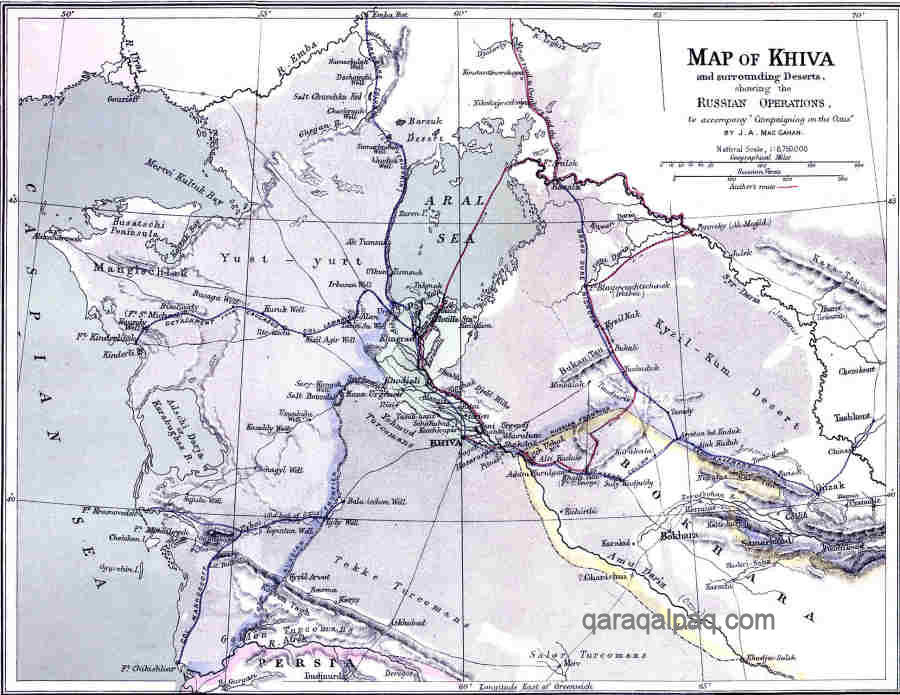
|
Map of the Russian operations, showing Kaufmann's route from Tashkent to Hazarasp.
From MacGahan's "Campaigning on the Oxus", published in 1874.
By a remarkable turn of events an adventurous American newspaper reporter from the New York Herald, Januarius MacGahan, had joined Kaufmann at his camp on
the Amu Darya and was allowed to accompany the Russian army as it marched on Khiva. Probably the very first Western war correspondent to report directly
from Central Asia, MacGahan had evaded Russian officers who had been sent to stop him and had then crossed the Qizil Qum alone to get an eyewitness
account of the fall of Khiva. He was given unprecedented freedom to follow events from the front, but like all "embedded" journalists he only saw events
from the perspective of his military hosts. Nevertheless thanks to him we have been left a detailed and highly readable report of the campaign.
First signs of water after crossing the desert. The water turned out to be a lake and not the Amu Darya.
From a sketch by N. N. Karazin, published in the Illustrated London News, 13 December 1873.
General Kaufmann's divisions crossing the Amu Darya at Sheikh-Aryk between 18-22 May 1873.
From a sketch by N. N. Karazin, published in the Illustrated London News, 22 November 1873.
Kaufmann finally crossed the Amu Darya near Hazarasp on 1 June, setting foot for the first time on Khorezmian soil. As he set out to march on the
citadel he was met by ambassadors of the local governor, who was an uncle of the Khan, offering the surrender and submission of the town. The Russians
therefore entered the citadel without firing a shot. They found that Hazarasp was a rectangular mud-built town surrounded by buttressed battlemented
walls and an outer moat, said by MacGahan to look a little like Windsor Castle from a distance! It was entered via a causeway crossing the moat and a
massive arched gateway with flanking towers. For troops who had just crossed the Qizil Qum, the region around Hazarasp was like a Garden of Eden, with
fields of waving grain, the fragrant blossom of mulberry, apple, apricot and cherry trees, tall young poplars and huge ancient elms providing dappled
shade, and with many little ponds and streams of water running in every direction. Peeping out from between the trees were the traditional Uzbek
farmsteads, built like little fortresses with buttressed outer walls strengthened with heavy corner towers, and arched and covered gateways.
While Kaufmann was approaching Hazarasp, General Verevkin, the head of the expedition from Emba, had completed a tough march down the barren west
coast of the Aral Sea and had finally reached the lush meadows and pastures of the northern delta. As he was preparing for his march on Qon'ırat the
following day, he received an extraordinary message from the governor, saying that he would refuse to fight unless the Russians were prepared to wait for
three more days by which time his canons would have arrived! Needless to say, Verevkin pushed on regardless and entered the town unopposed. Qon'ırat
was depopulated and in a terrible state of decay and desolation as a result of the continuing conflict with Khiva. The Aral Flotilla had already arrived
several weeks before and had already shelled Aq Qala and reconnoitred the lower reaches of the Amu Darya. As the Emba column left Qon'ırat, the
Mangishlaq column was just a couple of days behind them. Now the Russians began to encounter attacks by bands of local Turkmen and, at Xojeli, a
defensive force had to be dispersed by rockets. But it was only when the Russian column reached Man'g'ıt on 28 May that they were attacked by
the Khan's forces in numbers. The Khivans suffered heavy losses in this day of battle and thereafter their resistance deteriorated into hit and run
guerrilla warfare. On 4 June General Verevkin received a message from Muhammad Rahim Khan, begging an armistice and welcoming them as guests,
which he interpreted as a delaying tactic and consequently ignored.
Fearing that General Kaufmann was still some distance from Khiva, Verevkin decided he could not delay and set out on 9 June through the network
of surrounding gardens and farmsteads to reconnoitre the city of Khiva, only to stumble upon its outer walls by accident. Suddenly finding themselves
under fire from the city's defenders, the Russians were pinned down and General Verevkin was almost fatally injured. Unable to retreat, they held
their positions until their German-manufactured artillery could be brought into place to commence the bombardment of the city. The Khan sent out several
requests for a ceasefire, the last one saying that he had no control over his Turkmen troops which, though perfectly correct, was not a credible surrender
for the besieging Russian forces. The latter reluctantly ceased fire at sunset after they received orders to stop the bombardment from Kaufmann, who was
now only ten miles distant.
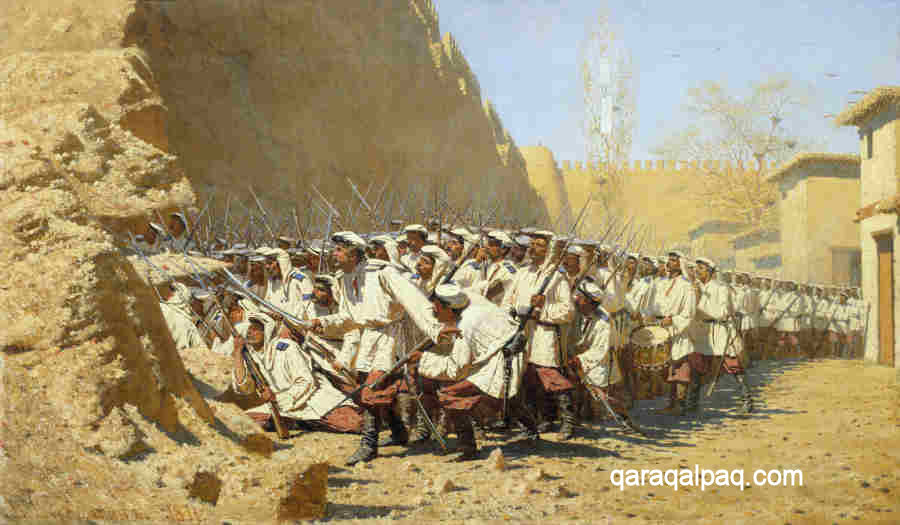
|
"Let them enter!" Russian troops in the process of capturing Khiva.
The painting by Vasiliy Vereshchagin attributed to 1871 but clearly painted at some time after June 1873.
An associated painting by Vereshchagin showing the aftermath of the bloody battle.
The next day General Kaufmann marched towards Khiva, but before reaching the city he was met by the Khan's uncle, the governor of Hazarasp, who had come
to surrender. The Khan had fled to Izmukshir after the belligerent Turkmen defenders had ignored his ceasefire instructions and the artillery barrage
had been maintained. Kaufmann continued his advance, meeting up with some of Verevkin's forces before victoriously entering the eastern Hazarasp gate
of the city. Meanwhile Verevkin's units, who were led by young gung-ho officers such as Colonel Skobelev and Count Shuvalov, were making the most of
overwhelming the final Turkmen resistance inside the northern gate.
"Mortally Wounded", another painting by Vasiliy Vereshchagin showing an injured Russian officer at Khiva.
According to MacGahan, everyone was disappointed by their first glimpse of the mundane inner city, with its cemetery, open spaces and trees, with a narrow
winding street lined with mud walls and mud houses, occupied by bearded men in dirty ragged khalats. However, once they entered the inner
citadel of the Ichan qala, they assembled in the great square in front of the Khan's rambling palace, the Kunya Ark, with its entrance gate flanked by
jade and white tiled towers glittering in the sun. Just to the left was the magnificently decorated Kalta Minar with brilliantly coloured bands of blue,
brown, and green including an upper band of Kufic script; in the distance the majestically elegant tapering minaret of the Juma Mosque; and to the rear,
the tiled but unfinished medresseh named after the current Khan. Kaufmann and his officers entered the Ark and assembled on the huge ayvan, used
as the Khan's audience hall, where they received refreshments from one of the Khan's ministers as the Russian band struck up "La Belle Hélène".
It must have been an extraordinary sight.

|
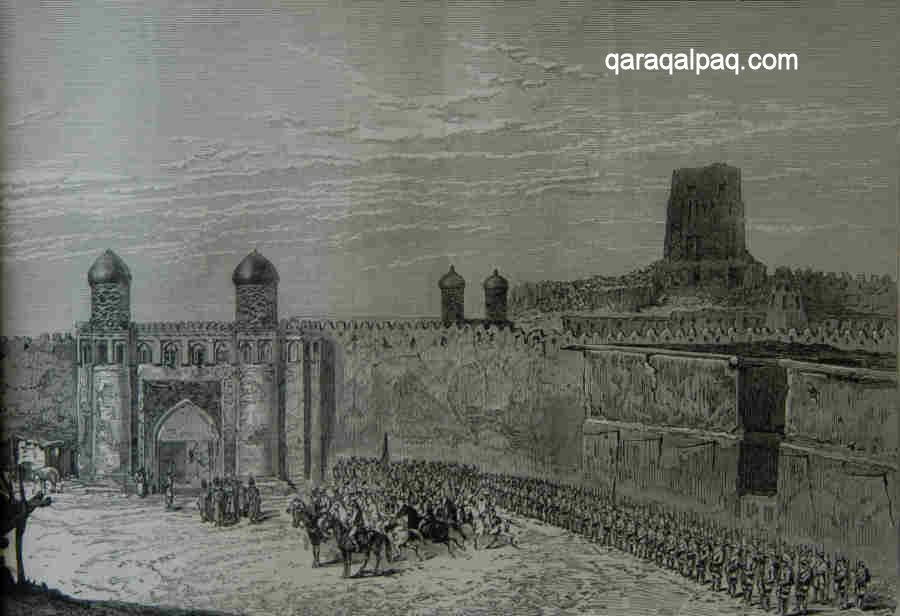
|
"The Celebration of Victory", an engraving from a sketch of Vasiliy Vereshchagin in Khiva.
Published in the Illustrated London News, 23 August 1873.
On 14 June the Khan returned to Khiva with his close followers and surrendered to Kaufmann, the huge figure of the young Khan kneeling in front of
the General who was only half his size. The Khan proposed that he should become a subject of the Tsar, but was told that the Tsar did not want to depose
him from the throne and was willing to show forgiveness subject to certain conditions. Work began immediately on composing a treaty between Russia and
Khiva.
Januarius MacGahan left us a great deal of detailed information on Khiva and Khorezm. It is clear that while Khiva had 300 shops, the main commercial
centre of the Khanate was at nearby Yani Urgench. Even at the time of the Russian invasion the wholesale merchants were importing a significant volume
of goods from Russia and Persia and the bazaars were selling Russian cloth and even chintz and muslin from England and Scotland.
From his writing one suspects that his initial feeling of disappointment on entering the city never disappeared:
"The exterior view of Khiva, from certain points, is striking and peculiar. High walls, with battlements and towers; a covered gate, with its heavy
towers of defence; the domes of the mosques and minarets, rising above the walls of the town; these things seen against the western sky in the light of
the setting sun, are very beautiful and picturesque; but the agreeable impression made by its exterior disappears on entering the town itself. There are
only three or four buildings in the whole place that make any attempt at architectural display; the rest are all of clay, and present but a miserable
appearance."
Yet at the same time he must have felt a sense of the magic of this remote and alien city that can still be experienced by the modern visitor today:
"It was now near midnight, and the silent, sleeping city lay bathed in a flood of glorious moonlight. The place was transformed. The flat mud roofs had
turned to marble; the tall, slender minarets rose dim and indistinct, like spectre sentinels watching over the city. Here and there little courts and
gardens lay buried in deepest shadow, from which arose the dark masses of the mighty elms and the still and ghostly forms of the slender poplars. Far
away, the exterior walls of the city, with battlements and towers, which in the misty moonlight looked as high as the sky and as distant as the horizon.
It was no longer a real city, but a leaf torn from the enchanted pages of the Arabian nights."
MacGahan had obtained his permission to travel into Central Asia with the help of Eugene Schuyler, the US Charge d'Affaires in Saint Petersburg. By
coincidence Schuyler was planning a trip to the Tien Shan, via the lower Syr Darya and Khokand, so the two set off on the first part of their epic
journeys together, sharing a railway carriage from Saint Petersburg to the Volga and then travelling by horse and carriage to Fort Number 1 at Kazalinsk
to avoid being intercepted by Russian security guards. Their carriage route passed along the northern shores of the Aral Sea, and Eugene Schuyler
recorded his observations of the Aral in his detailed travel diary:
"One day, near the station of Ak-julpas, for about three hours before sunset our road lay along the smooth beach of a bay of the Aral Sea. Far out in
the west we looked over an expanse of shallow water rippled by the wind, and forming pools on the flat sandy beach. In the distance was a low dark blue
promontory, and faint blue coast-lines, and to the east and south the desert rising and falling in low hillocks, covered with low leafless shrubs, the
coloured stems of which gave an aspect of purple, rose and yellow, mingling with the yellow-brown of the sand. But the charm lay in the sky, light blue
with fleecy clouds, and a sun which lighted up the clear, very clear, shallow pools of water and shore and sea with silver and pearly hues. White gulls
soared and dipped into the bay, hovering over our heads; while further away the water was covered with flocks of ducks and other water-fowl ..."
"The appearance of this shallow bay of Sary-Tchaganak is an example of the whole of this vast inland sea, a veritable waste of waters, 270 miles long by
160 broad. The surroundings are utterly desolate and uninhabited everywhere sandy hills and stretches of desert. Except birds, there are very few
signs of life ... The sea is shallow ... On the east and south one can walk for miles through the shallow water, and during the time of strong winds
the bed is for a long distance almost dry. Owing to the absence of good harbours, and the difficulties of getting into and out of the mouths of the Syr
Darya and the Oxus, the sea is almost unnavigable."
According to MacGahan, there were 22,000 Turkmen kibitkas, or households, in the region of Khiva at that time, of which half belonged to the
Yomut tribe, the rest belonging to Chodor (3,500), Imreli (2,500), Karadashli (2,000), Kara Jigeldi and Ali-Eli Goklen (1,500 each). This was
equivalent to a local population of 110,000 people, allowing for five members per family. During the treaty negotiations, the Khan had told Kaufmann that
he could not be responsible for the payment of the Turkmen share of the war indemnity, since even in peacetime they refused to pay any taxes. Kaufmann
decided he would collect the war indemnity from them directly, although this may have been a scheme to subdue the troublesome Turkmen tribes, since he
must have known they had no way of paying the sum that he set. He issued a proclamation ordering the Yomut to pay 300,000 roubles, equivalent today to
nearly $5 million, or almost $100 for every man, woman and child, with a deadline of two weeks. Before waiting for the deadline to expire he began
preparing to attack the Yomut encampments, much to the dismay of some of his officers, and then seized and imprisoned a dozen Yomuts who had come to
negotiate with him.
On 19 July, five weeks after the surrender of Khiva, a heavily armed column of Russian troops under the command of General Golovatchov headed off
towards the Hasavat canal, which supplied water to the Yomut settlement. MacGahan accompanied the Russian forces, having been encouraged to stay on by
the young Russian officer, Colonel Skobelev, who had struck up a close friendship with him. Finding the settlement abandoned the Cossack cavalry were
ordered to set fire to the Yomuts thatched mud huts, yurts and stacks of wheat and straw. After some time the Russian advance guard caught up with the
retreating Yomuts, men, women, and children, with their livestock and carts carrying all their worldly possessions. Eventually the Russian commander gave
the order to attack and the Cossack cavalry charged into the crowds, guns blazing and sabres flashing, while the infantry reinforced the attack with
rocket fire. Although attempts were made to spare the women and children, many were killed or injured during the massacre.
For the next few days the Russians continued through Izmukshir towards Il'jayli, incinerating anything that would burn throughout the Turkmen territories,
finally making camp in a region of Uzbek settlement. It was here that a party of Yomuts on horseback surprised them with a counterattack, and although
only a few were killed on either side it reminded the Russians that the Yomut could be an effective foe. This observation was reinforced two days later
when the Russians set out early in the morning to engage the waiting Yomut, only to be surprised once again by a clever ambush. The Russian commander was
injured and for a moment MacGahan thought that they would be routed, but the Yomut only had sabres and agricultural scythes and the rifles of the
disciplined Russian infantry soon made mincemeat of them. The Yomut later admitted to the loss of 500 tribesmen compared to 40 dead and wounded Russians.
Over the next two days the Russians attempted to hunt down the fleeing Yomuts, who had set off again with their families and possessions in their
arbas. By the time MacGahan had caught up with the vanguard of the Russian force, the Yomuts had been overrun. Unable to cross the canal, the
Yomuts had released their horses and fled, leaving those without a saddle to be cut down by the Cossack sabres. Dead Yomut tribesmen lay all about,
covered in bloody sabre-cuts, while their mothers, wives, and children cowered under their arbas loaded with carpets, cooking utensils and
clothing.
The Russian commander decided that the Yomuts had been punished enough. The Russian troops pillaged the carts, taking the best carpets, silk, and
jewellery and then set fire to the remains including the hundreds of arbas. The Yomut livestock was rounded up and herded back to Khiva. The
Yomut's livelihood had been completely destroyed.
General Kaufmann, who had come with reinforcements from Khiva, now set up camp at Il'jayli and issued a proclamation to the remaining Turkmen tribes,
demanding an enormous indemnity, equivalent today to over $400 per kibitka, to be paid within 14 days. The Turkmen attempted to pay in kind,
with horses, camels, carpets and a large amount of silver jewellery, with the Russian officers keen to acquire a genuine Turcoman horse and the large red
and white Turkmen main carpets selling for the equivalent of over $500. However, at the end of the deadline the Turkmen had only paid half of the total
indemnity. Realising their difficulty in raising the full sum, Kaufmann gave them another year to fulfil their obligations.
Russian Khorezm
Within weeks of the fall of Khiva, General Kaufmann had sent a draft of his proposed treaty with the Khan to Saint Petersburg for approval. The approved
copy was returned to Khiva and an Uzbek translation was prepared for the Khan. It was signed on 23 August 1873 in the Khan's garden at Gendiamin.
The Khan was allowed to retain his position as the legal sovereign, but only as a "humble servant" of the Russian Emperor. In return the Russians would
have a right of residence in the Khanate, freedom to conduct trade unburdened by taxation, and an indemnity of 2.2 million roubles to be paid with
interest over about 20 years. Despite clear instructions that he should not annex the Khanate, Kaufmann pushed his luck and persuaded the Khan to cede
not only the left bank of the Syr Darya to Russia but all of his lands on the right bank of the Amu Darya as well. This would become the Amu Darya region
of the Syr Darya Province of Russian Turkestan, to be administered by a new Amu Darya Department. The Khan would control the whole of the left bank, up
to the foot of the Ustyurt and the region of the Uzboy as far as the Caspian Sea. However Russia would take the entire Ustyurt plateau and would control
the Caspian coast. When news of the treaty reached London there was a hostile reaction by the British who realised they had been duped by Saint
Petersburg. Right-bank Khorezm had become the latest colonial territory to be added to the growing Russian Empire.
The Russians now turned towards the defence and administration of their new Amu Darya Otdel or Department, within the larger Syr Darya
Oblast ruled from Tashkent. At the time of its annexation its two main towns were thought to be Shoraxan, close to the Amu Darya and just
south of modern To'rtku'l, and Shımbay. General Ivanov was installed as the first Commandant of the new territory, responsible for exercising
military control over Khivan affairs on behalf of General Kaufmann. The first Russian fort was erected in the garden of the Khan's Vizier close to the
banks of the Amu Darya, 3km from Shoraxan and 10km from the Amu Darya ferry. It was named Fort Petro-Aleksandrovsk (close to modern To'rtku'l). During
that winter a second site was identified for the erection of another garrison close to the village of No'kis, strategically situated at the beginning of
the Aral delta, with one of the best river crossings and at the start of the road to Kazalinsk. General Ivanov initially decided to garrison the bulk of
his troops at No'kis and work began on the construction of the fort during the summer of 1874. Unfortunately the location turned out to be less than
satisfactory, with the site subject to flooding and with no clay available for brick-making. Ivanov therefore decided to limit the size of Fort No'kis
to 350 men and to site his main garrison at Petro-Aleksandrovsk, which would now become the main administrative headquarters for the Amu Darya Division.
The Russian fort was located to one side of a large open square and was surrounded by a wall with an imposing gateway. Gradually a European-style town
grew up around the square and by 1885 it had a general shop, a small hospital, a public baths, and houses for the governor and families of the senior
officers. Over the next few years a permanent dock was built at No'kis for the Aral Flotilla, which now had 550 sailors, about half a dozen paddle-wheel
steamers, and a dozen heavy barges for transporting troops.
The Russian takeover of Khiva suddenly opened up Khorezm to Europe and the West, although foreigners were not allowed to visit Turkestan without special
permission. Now the Russian paddle steamer "Perovsky" could ferry passengers from Kazalinsk to No'kis across the Aral Sea, making it possible to reach
Khiva from Orenburg by carriage and boat without the perilous crossing of the Ustyurt. Russian surveyors, economists and geographers flooded into the
region to compile their various reports, and travellers and adventurers soon followed behind them. Between 1874 and 1880 some five separate expeditions
came to map, chart and survey the lower Amu Darya. Thanks to the Russian photographer Krivtzov we even have a photographic archive of the Ichan qala and
the surrounding residential area of Khiva as early as 1873, showing it to be a rather scruffier and run-down version of what we see today, apart from the
later additions such as the Islam Khoja ensemble. In reality it was probably always like this the modern Ichan qala tourist site is a much-
restored, depopulated and sanitised Walt Disney version of the original city, though still fascinating nevertheless. Another Russian visitor to Khiva
at this time was A. L. Kun from Saint Petersburg, who relieved the Khan of more than 1,500 manuscripts, including the history of the Khanate written by
Munis, taking them back to the Russian capital for study.
View of Khiva, showing the Kalta Minor, Muhammad Amin Khan Medresseh and the Kunya Ark.
Photographed by Grigoriy Krivtzov in 1873.
Just as important was the information that was gathered in rural Khorezm showing the state of the ordinary people. Quite remarkably the Russians invited
an English military river and irrigation specialist from the Royal Engineers to Khorezm shortly after the annexation. Major Henry Wood has given us an
interesting picture of life in the lower Amu Darya and delta in 1874, albeit somewhat preoccupied with water. Wood visited Khorezm in the summertime
after a 15-hour cruise down the eastern side of the Aral Sea from the headquarters of the Aral Flotilla at Kazalinsk. He was moved by his first sight of
this waveless green expanse of sea, surrounded by swamp and desert and devoid of other ships or ports. Entering the central arm of the Amu Darya, the
banks were lined with tall rushes, behind which lay impenetrable scrubby and thorny tugay jungle. The latter was the home of the tugay
tiger, a natural predator of the wild deer and boar which thrived in this remote wilderness. The central region of the delta was still wild with
weed-choked lakes filled with coloured water lilies and stands of reeds almost as tall as trees "... adding immensely to the sense of solitude and mystery
which pervades these uncommon scenes". In the flood season the whole area from Xojeli to Qon'ırat became one huge lake. The mosquitoes were so
dreadful and "exquisitely painful" that even the hardy Russian soldiers had been issued with protective nets!
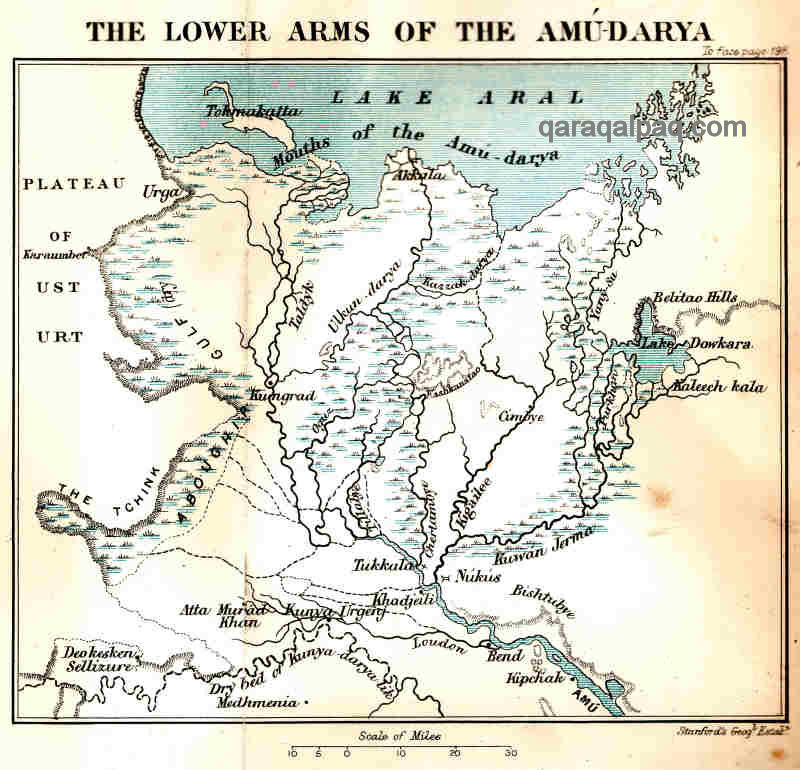
|
A map of the Amu Darya delta in 1873.
From Henry Wood, The Shores of Lake Aral, London, 1876.
This central delta area was occupied by the Qaraqalpaqs, described by Wood as the poor underdogs of the region, despised by both their Uzbek and Turkmen
neighbours. Their material situation had changed very much for the worse over the last 18 years. During the 1858 rebellion the Yomut Turkmen who
cultivated land in the Aybugir Gulf had rebelled alongside the Qaraqalpaqs. The Khan of Khiva, Sayyid Muhammad Khan, decided to kill two birds with one
stone and dammed the Laudon canal, depriving the Turkmen of water and flooding the Qaraqalpaqs. Unfortunately every summer since the excess water had
turned the important Qaraqalpaq pastures into swamps at just the time they were needed for cattle-grazing. The population of Qon'ırat had
consequently shrunk from 6,000 to 2,000 since the 1850s and even the population of Shımbay, the second town in the delta, was a mere 1,200,
although Wood reported the total Qaraqalpaq population to then be 50,000, probably an underestimate. Qon'ırat was the main agricultural area,
with small patches of cereals, melons or lucerne and with the wetter areas used for rice farming, with the local Qaraqalpaq urchins guarding the crops
from flocks of wildfowl. On the left bank of the river at Qon'ırat, areas of pastureland alternated with patches of low thick jungle.
Shımbay had fields of maize and lucerne with fruit orchards and irrigation channels lined with poplar trees. However that summer the whole
region was plagued by vast swarms of locusts. Many Qaraqalpaqs were fishermen, living on floating islands of vegetation and using fixed nets to catch
large coarse sturgeon, which they dried and salted for sale.
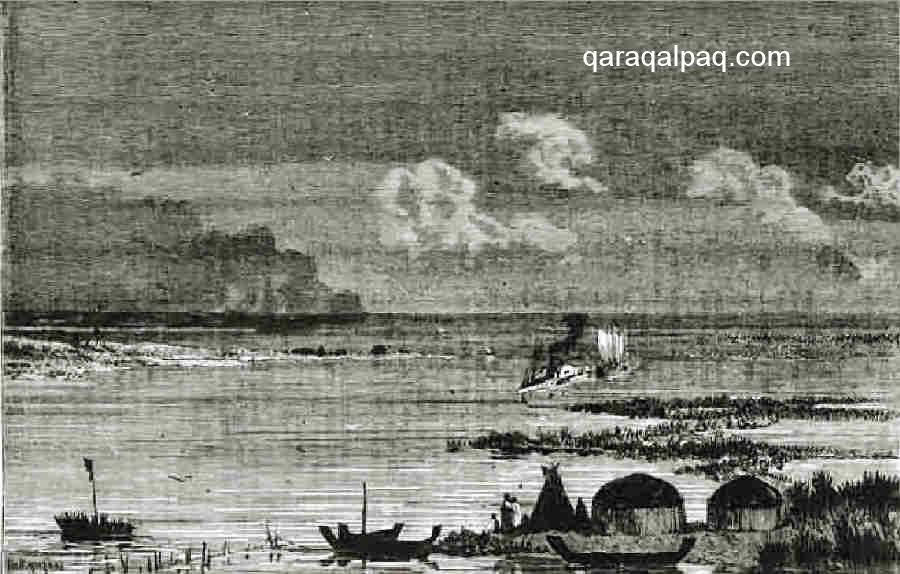
|
Qaraqalpaq yurts and qayıqs at the mouth of the Ul'ken Darya,
with the gunboat "Samarkand" moored in the distance. Sketched by Nikolay Karazin in 1873.
The region around Khiva was much more prosperous with thousands of fortified farmhouses, or ha'wli, occupied by the wealthier feudal landowners.
The range of crops grown in this region was much wider, with good quality cotton, wheat, maize, lucerne, sesame, hemp, and madder as well as tobacco and
opium, the latter two crops highly taxed. Tree cultivation was also widespread around Khiva, not just for fruit but also for timber. There were some
fortified ha'wli in the vicinity of Shımbay, but none further into the delta. No'kis was then just a mud-walled village a mile or so from
the new Russian fort and was situated in a flat region of thick tamarisk and eleagnus jungle.
Sadly Wood does not describe the towns of Khorezm, but we do get a brief picture of some of them from Captain Burnaby who visited the region two years
later and wrote a book that is somewhat short on detail. He found New Urgench surrounded by high walls in a very bad state of repair, many having
crumbled into the outer ditch. Nevertheless the town was a major centre of trade, with the roads blocked by hundreds of carts delivering corn and
"various kinds of grass" to the market. Burnaby witnessed a caravan of camels one mile long, bringing in goods from other parts of the Khanate. The
busy bazaar occupied a street that was covered with rafters and straw to provide shade from the sun. The surrounding countryside was occupied with square-built houses
with gardens enclosed by high walls. As Burnaby approached Khiva he could see "richly-painted minarets and high domes of coloured tiles" towering above
the leafy groves and orchards that surrounded the town.
"We now entered the city, which is of an oblong form, and surrounded by two walls; the outer one is about fifty feet high; its basement is constructed
of baked bricks, the upper part being built of dried clay. This forms the first line of defence, and completely encircles the town, which is about a
quarter of a mile within the wall. Four high wooden gates, clamped with iron, barred the approach from the north, south, east and west, whilst the walls
themselves were in many places out of repair."
"The town itself is surrounded by a second wall, not so high as the one just described, and with a dry ditch, which is now half filled with ruined
debris. The slope, which leads from the wall to the trench, had been used as a cemetery, and hundreds of sepulchres and tombs were scattered along some
undulating ground just without the city. The space between the first and second walls is used as a market place, where cattle, horses, sheep and camels
are sold and where a number of carts were standing filled with corn and grass."
Burnaby had reached the bazaar square, opposite the Hazarasp gate. This had been one of the traditional places for execution within the city:
"Here an ominous-looking cross-beam had been erected, towering high above the heads of the people with its bare gaunt poles."
"This was the gallows on which all the people convicted of theft are executed; murderers being put to death in a different manner, having their throats
cut from ear to ear in the same way that sheep are killed."
Execution by cutting the throat also took place in a deep square pit close to the Khan's palace, while hangings also took place on the north side of the
citadel, by the slave market, where there was also a stake for impalement. Cruelty lay at the very heart of the Khanate's regime. Burnaby passed on
into the inner citadel:
"... The streets are broad and clean, whilst the houses belonging to the richer inhabitants are built of highly polished bricks and coloured tiles, which
lend a cheerful aspect to the otherwise somewhat sombre colour of the surroundings. There are nine schools; the largest, which contains 130 pupils, was
built by the father of the present Khan. These buildings are all constructed with high, coloured domes, and are all ornamented with frescoes and
arabesque work. The bright aspect of the cupolas first attract a stranger's attention on his nearing the city."
The conditions of the ordinary people in the countryside were dreadful at this time. Excluding the feudal lords, most people lived in yurts, grouped
into small villages of tens or hundreds of dwellings. The peasants were not only abjectly poor but were at constant risk of attack from bands of
ravaging Turkmen, especially in the winter when the frozen rivers and lakes made access easier. With only two battalions under his command, General
Ivanov simply lacked the resources to protect the newly annexed right bank territories from these Turkmen incursions. We know he wrote several letters
to the Khan insisting on restitution following Chodor thefts from the Qaraqalpaq. The artist Nikolay Nikolayevich Karazin returned to Khorezm to paint
in the summer of 1884, but discovered that many Qaraqalpaqs were living in squalid conditions. Reeking of rotten fish, their yurts lacked any carpets
or felts and contained little more than an iron trivet and cauldron with a few reed mats on the floor. Most of the awıls, or small
villages, were equally impoverished and Karazin did not see a single healthy person during his visit even the livestock looked sickly. Karazin left
a picturesque description of the stifling heat, the myriad of mosquitoes, the vast plagues of locusts, the rivers teaming with fish and the lakes and
marshes alive with pelicans, swans and flocks of small birds.
"A Karakalpak of Asiatic Origin". Published in the Illustrated London News, Special War Number, 23 May 1877.
The local Qaraqalpaqs regarded the Russian invaders, or "white shirts", as friends of the devil. The Aral Flotilla paddle steamers were called "devil
boats" because they constantly cut the fishing nets of the local fishermen who lived in riverside dwellings built on artificial reed platforms. They
sought revenge by repositioning the navigation markers, trying to trick the boats into side channels where they would run aground. For protection
during the bitter delta winter the Qaraqalpaqs moved their yurts from their summer grounds into huge mud-walled enclosures, located in many places
including Qon'ırat, Shımbay, No'kis, Bozataw, and the Aral Sea coast. Karazin estimated the Shımbay enclosure had a diameter of 1½
kilometres, contained 40,000 yurts and even had its own covered bazaar.
Poor Qaraqalpaq barge haulers or qayıqshi on the Amu Darya.
Sketched by Nikolay Karazin, who described them as "semi-barbarian paupers".
However, not every yurt-dweller lived in abject poverty. A. Kaulbars, who arrived with Kaufmann in 1873, visited a decorated yurt with carpets and bags
hung from the inside walls, some filled with provisions, several iron cooking pots, millstones and weapons. But he also observed poor men who could not
even afford to live in a yurt, especially the Qaraqalpaqs in the northern delta who were forced to live in tents or dugouts.
Henry Lansdell reported that by 1885 the condition of the nomads in the southern portion of the Amu Darya Province around Shoraxan was slowly improving.
Because the nomads were vulnerable to Turkmen raiding parties from the left bank, they had had to remain inland close to wells far from the river, and
could not take their cattle to the best pastures along the banks of the Amu Darya during the spring and autumn. To help the nomads develop their herds,
the Russian governor had established a military post at Uch Uchak, close to the Bukharan frontier, to defend the surrounding riverbanks and regions of
tugai forest.
Of course Russia's expansion into Central Asia did not stop with Khorezm. Despite the punitive action against the Yomuts during Kaufmann's campaign,
raids by Turkmen nomads began immediately after the Russian forces departed from Khiva, partly in an attempt to recoup their losses. Since the Khan had
been left in control of left bank Khorezm without any military forces, he was powerless to control the Turkmen minority who could only be restrained by
direct intervention by General Ivanov's garrison at Petro-Aleksandrovsk. This led to repeated requests from Ivanov for the complete annexation of Khiva,
a request continually rejected by Saint Petersburg. However, when it came to the Turkmen tribes to the south and east of Khorezm, Tsar Aleksandr II was
left with little alternative than to allow his officers in the field to take an increasingly aggressive stance. As early as 1877 the Russians had
attacked the fort of Qizil Arvat, but the Russo-Turkish War intervened and momentum was lost. In 1879 another Russian expeditionary army advanced from
Chikishlar and attacked the Tekke at their Geok-Tepe fort in the Akhal oasis. After an artillery barrage the Russians tried to storm the fort but the
Tekke fought like devils, killing and wounding 450 attackers and forcing them to retreat back to the Caspian.
The defeat embarrassed the Russians, who resolved to crush Turkmen resistance. At the beginning of 1880 Tsar Aleksandr summoned Mikhail Skobelev to a
meeting in Saint Petersburg and instructed him to conquer the Akhal Tekke once and for all. Skobelev, now known as the "White General", had become a
distinguished soldier following his exploits at Khiva and had gained a formidable reputation. Skobelev realised that transport and artillery would be
the key to success and immediately formed a railway battalion who began to build a railway line from the Caspian port to Qizil Arvat. Realising that
yurts were relatively undamaged by normal artillery shells he ordered special ammunition that had been charged with petroleum. At the end of the year,
his expeditionary army reached and surrounded the stronghold of Geok-Tepe. After a siege and numerous violent skirmishes, Skobelev's sappers finally
managed to mine the ramparts and in the early morning of 24 January 1881 a stretch of the mud-brick fortification was blown to dust. In the bloody
hand-to-hand fighting that followed some 4,000 Turkmen were massacred and many thousands more were hacked to death by the flying columns who pursued the
escaping fugitives. The cost to the Russians was 300 lives. News of the defeat was received with uproar in London and with dismay by the other Turkmen
tribes and the old regime in Khiva, who still hoped beyond hope that their independence might one day be restored. The Russian advance looked
unstoppable. Skobelev was unapologetic for the massacre and later commented, "... in Asia the duration of the peace is in direct proportion to the
slaughter you inflict upon the enemy. The harder you hit them, the longer they will be quiet after."
Within a few years the Russians had negotiated the submission of the Turkmen tribes in the Merv oasis, completing the conquest of Turkmenia. The
Transcaspian Oblast soon became the fifth and final province of Russian Turkestan. The annexation of Merv caused enormous concern in Britain
over Russian ambitions for Iran and India, which were only heightened when local Russian military leaders captured the Afghan frontier region of Pandjeh,
following Russian reassurances that their advance into Asia was complete. A Russo-British war looked imminent for a while, but fortunately diplomacy won
the day and an Afghan Boundary Commission was convened in 1887 to establish the dividing line between the Russian and British colonial territories.
The agreed borderline defined the Russian sphere of influence for almost a century until Russian tanks crossed the Amu Darya into Afghanistan in 1979.
The official Soviet histories are keen to emphasise the benefits that came with Russian control. However in reality Russian policy was one of
non-interference and Khorezm remained largely isolated and stuck in a time warp. Obviously there were external influences, but they were limited. When
Muhammad Rahim Khan attended Aleksandr III's coronation in Moscow he returned with cigarettes and a telephone and introduced the ladies of his harem to
corsets and bustles! One of the very first Russian schools to open was in Khiva in 1884, and was founded by a local official after returning from a visit
to Moscow and Saint Petersburg. Schools for boys and girls were opened in Petro-Aleksandrovsk along with a library in 1907, and more schools were
opened later in Shoraxan and Shımbay. However these were solely for the benefit of senior Russian officials and local members of the aristocracy.
The vast majority of the population remained illiterate, their only opportunity for a rudimentary education being through the local mullah in a
mekteb, or religious elementary school, where boys were taught to read the Qur'an. Tribal leaders who could afford it would try to send their
boys to medressehs in Khiva or even Bukhara. A hospital opened in Shabbaz (modern Biruniy) and first-aid posts in No'kis and Shımbay, although
for the ordinary population illnesses continued to go untreated and the death rate remained high. Roads were built including the "Russian Road" from
Petro-Aleksandrovsk to Shımbay via No'kis.
The sheer isolation of Central Asia from Europe demanded faster communications and General Kaufmann promoted the idea of a railway from Orenburg to
Tashkent. Despite the completion of a survey by 1879, showing that a line could be constructed across the Qara Qum, it was never built. As we have
already seen, the first railway was constructed for purely local military reasons from the harbour of Asunada, south of the port of Krasnovodsk on the
Caspian, to Qizil Arvat in Turkmenistan in 1881 by General Skobelev. It was finally decided to extend this line to Ashgabat in 1884-85 but the
Anglo-Russian dispute over Pandjeh in 1885 made the construction of a Tashkent railway a strategic priority and by the end of 1886 the railway line had
already reached the bank of the Amu Darya opposite Charjou. Work began on continuing the line northwards with the construction of a wooden bridge over
the Amu Darya the following year, the railway reaching Samarkand in 1888 and eventually Tashkent in 1898 a massive investment and an incredible
achievement. Colonel Le Messurier, a military officer from England, travelled the line in the autumn of 1887. At that time the railway was entirely
under Russian military control and already had approximately fifty engines and a large amount of rolling stock. Although essentially a tourist, le
Messurier recorded the details of the railway like a military observer, and noted that the whole 665 miles from Asunada to Charjou could be traversed in
53½ hours, including stops. On reaching the Amu Darya, le Messurier was told that the wooden bridge would be finished in January, in another three
months. Two fast and armed steamboats along with two barges were also nearing completion at Charjou, having been transported there in parts by rail.
They were intended to patrol the river between Khiva in the north and Kerki in the south. Another railway line was constructed from Orenburg to Aralsk
around 1900 and extended to Tashkent in 1906. In 1912 Petro-Aleksandrovsk was linked to Charjou by telegraph.
Having requested protection for so long the Qaraqalpaqs on the right bank were at last under Russian rule. However in practice the imperial authorities
left them under the continuing control of the Khivan Khan, so whether left bank or right bank, Qaraqalpaqs remained subject to the same oppressive system
of Khivan rule. The taxation system, and the systems of water rights and of land use remained unchanged. However there was a gradual increase in
security, with the interminable feudal wars put to an end, and with attacks by the Turkmen feudal chiefs deterred by Russian border patrols.
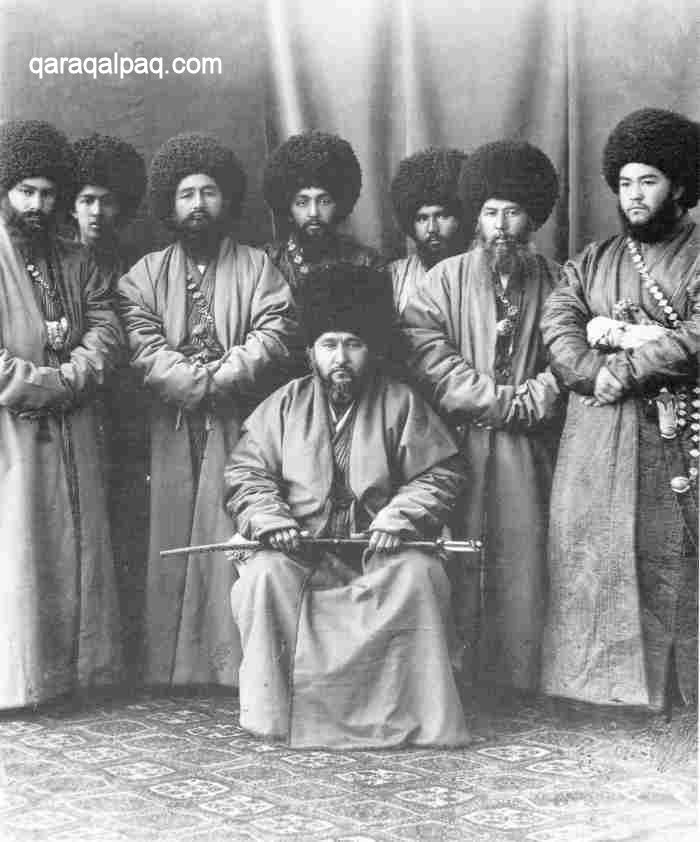
|
Sayyid Muhammad Rahim Bahadur Khan II (1864-1910) with his ministers.
Photographed by I. Volzhinsky not later than 1896.
Soon Russian merchants began to arrive and they established a wholesale agricultural market for the purchase of seed, dry fruit, wool and fish. Traders
carried cotton, wheat, hides and skins, dried fruits and fish overland along secure caravan routes to Orenburg, or else by boat to Charjou, and then by
rail into Russia. They returned with cotton and wool textiles, dyes, kerosene, sugar and tea for sale through local bazaars and retailers. The economy
began to transform itself into one based on monetary exchange rather than primitive barter. Cotton fields were expanded to satisfy the demands of the
Russian market and Qaraqalpaq alfalfa was exported to Germany, the USA and Argentina. By the end of the century astrakhan pelts, wool, butter, and fish
were also being exported. Small businesses began to open and flourish and there was an increase in the construction of clay houses, or tams.
Shımbay, Qon'ırat and Xojeli gradually began to develop into small towns and some of the Uzbek population around Khiva even migrated north to settle
in the Shımbay region.
Khorezm's trade with Russia grew from around 3 million roubles in 1873 to nearly 12 million in 1898, and reached 18 million by 1908. Cotton production
grew six-fold between 1885 and the early 1900s, much of the growth coming from the increased cultivation of American cotton strains. However, unlike
Bukhara, the inaccessibility of the railway remained a major limitation on the full development of Khorezm's economy. Over time a colony of Russian
merchants gradually established themselves in Urgench, cotton being the major item of trade.
Probably the finest historical description of Khorezm ever written by a foreign visitor was penned by the Danish traveller, Ole Olufsen, who has given
us a wonderful picture of the country after a quarter of a century of Russian rule. Olufsen spent several years in the Khanate of Bukhara, including
"mountain" Bukhara, now western Tajikistan, and in 1899 voyaged down the Amu Darya in a small qayıq from Charjou to visit Khiva, New Urgench,
Xojeli and the ruins of Kunya Urgench, returning via Hazarasp and Petro-Aleksandrovsk. Navigating between sandbanks and islands filled with grazing
livestock he passed by the reed-fringed banks of the Amu Darya and the changing scenery of marshes, desert and dunes, and woods of poplar and tamarisk
beyond. Here and there the banks were dotted with yurts and houses made of reed mats or clay, Turkmen living on the west bank and Qazaqs on the east.
His overriding impression of Khiva was of a labyrinth of narrow unpaved streets lined with clay houses. The Ichan qala was surrounded with its high
crenellated wall strengthened with numerous bastions, the winter quarters of the Khan with a high watchtower occupying one end. The tallest buildings
were the fine Pakhlavan Mosque, its turquoise dome topped with triangular flags, the Kalta Minar, and some half-dozen minarets. Olufsen thought that the
most attractive mosque was the one built by Allah Quli Khan and used by the Khan for prayer, with its many verandas and beautiful blue and white tile
work presumably a reference to the Tash Hauli Palace. He was impressed that the many handsome medressehs and mosques were still maintained in good
repair. The citadel had a small bazaar or serai, consisting of a few gloomy brick vaults and a few radiating covered streets filled with tiny
stalls, mainly selling Russian goods. The outer town between the citadel and the outer wall had groups of clay houses, open grounds and stinking
rush-choked ponds. The Qara Qum lay close to the south of the city, but to the north were plantations of fruit trees and poplars with many estates
surrounded by high clay walls, containing houses defended like small fortresses with their gates barred at night.
Olufsen was invited to two audiences with Muhammad Rahim Khan, with the Khan perched on a common felt carpet on a raised clay platform in his garden,
dressed in a simple brown and blue striped chapan wearing a tall sheepskin hat. Now aged 54 the Khan had reigned for the past 36 years, yet came across
as rather modest and shy, if not perhaps a little coarse. He later met the Khan's fourth son, Isfandiyar, who was just 27 and looked tall, pale and
intelligent with a thin moustache.
From Khiva Olufsen travelled by arba to New Urgench, which also had high crenellated walls with conical bastions, about 6,000 inhabitants and
a local cotton-growing industry. Qıpshaq, right on the river bank, had a small bazaar surrounded by a yurt encampment, while Xojeli was just a mud town
of poor appearance containing no more than 150 houses within a ruined outer wall. Sadly he chose not to travel further into the delta and therefore
denied us a description of the Qaraqalpaq territories, although he did note that the Qaraqalpaq were tall, strong and peaceable, although not very
intelligent. "They are even looked upon as the dullest persons in Central Asia, and every Uzbek is ready to make fun of the Karakalpak on his appearing
in the bazaar". This was very much a biased Uzbek view of the Qaraqalpaq people, still held by many up to the present day. After visiting the ruins of
Kunya Urgench, Olufsen returned via the small Russian town and garrison at Petro-Aleksandrovsk, finally calling at the densely populated region of
Hazarasp before returning to Bukhara. Hazarasp still had the remains of its old city wall, with its semicircular bastions and just a single gate defended
by two ruined towers.
Repression and Dissent
Meanwhile, back in Russia, opposition to the autocratic regime of Tsar Nicholas II, who had come to power in 1894, was gaining momentum. Marxist ideas
had become fashionable within the intelligentsia; a radical student movement was developing in the universities; and the growing industrial sector was
experiencing a mounting wave of strikes by discontented workers. A national university strike in 1899 was followed by a peasants' revolt in the Ukraine
in 1902 and a socialist terrorist campaign resulted in the assassination of several ministers. A failed war with Japan only increased dissent and in
early 1905 tsarist guards butchered a peaceful workers' march on the Winter Palace. "Bloody Sunday" as it became known unified the political opposition and
led to a general strike later that year that forced the Tsar to introduce limited reforms, including a parliamentary assembly (the Duma).
This rising tide of unrest had little relevance to the ordinary people of Central Asia, where most of the non-Russian population were uneducated,
illiterate and generally unaware of developments in Russia. The local Muslim population were more concerned about their farms and pastures, about high
taxation, about autocratic and corrupt officials, and just trying to stay alive. In the Kazakh Steppe Regions of Uralsk, Turgay, Akmolinsk and
Semipalatinsk the increasing resettlement of Russian immigrants on traditional grazing lands was also a major issue.
The situation in Khorezm was even more muted because there had not been any significant influx of Russian immigrants even by 1912 there were only
6,150 Russians in the Khanate, mainly in Urgench. Khorezm had no railway until after the Great Patriotic War, and the main industrial activity consisted
of just nine steam-powered cotton ginning mills in 1900 (mainly Russian-owned) and in 1908 there were only eleven, of which four were in Urgench and
three in Dashoguz. Russia had virtually ignored Khorezm for a quarter of a century and the Khan was given little status and had minimal contact with the
Russian administration in Tashkent or Saint Petersburg. As such no attempt had been made to modernize the mediaeval and despotic system of rule under
the Khan. For example it was only after 15 years of Russian rule that the Khan announced the abolition of torture in Khorezm. It was inevitable that
unrest in Russia would gradually filter into Khorezm and from 1900 onwards there was increasing militancy in the province, which worsened after 1905
while always remaining fairly small-scale. It was fuelled by imported revolutionary ideas and literature, and indeed, directly by the revolutionaries
themselves, many of whom had been exiled to Petro-Aleksandrovsk prison. Fishermen, barge-haulers, workers in cotton mills, ordinary soldiers, and sailors
in the Amu Darya Flotilla began to protest over pay, conditions and authoritarian rule. A decision by the authorities to commandeer large swathes of
tugay forest for the commercial production of firewood led to enormous resentment by peasants living in the delta, who could no longer use these
areas for grazing or for collecting firewood for themselves. A delegation from Shımbay explained that half of the local population had no means
of purchasing firewood, lived in decrepit kibitkas and were already close to starvation.
Instead of responding positively to these grievances, the Governor of the Amu Darya district simply cracked-down on dissidents, the activists being exiled
to Siberia. A very poor harvest in 1910 led to higher food prices and to numerous cases of death from starvation, especially in the Shımbay and
Ko'k o'zek districts of the delta, and even around Khiva. This led to attacks on wealthy farmsteads, yet more refusals to pay taxes, and acts of
non-cooperation in activities such as canal clearing. Revolutionary "unions" were formed in Khiva, Urgench, Khanqa and Dashoguz.
The main call for political change came from a small group of young intellectuals, who were the sons of beys and rich merchants. Educated in
local Muslim schools, Russian Universities, or in Istanbul these Jadidists, as they came to be known, wanted to see independence and modernization in
Central Asia. The movement had its origins in the 1860s and by the turn of the century had become the principal voice of local opposition to Tsarist
rule, although its main strength was in Tashkent and what would become eastern Uzbekistan. As early as 1898 a Muslim cleric had rallied his supporters
to attack the Russian garrison in Andijan in the Ferghana Valley. The Jadidists hopes of reform were boosted in 1905 by the unexpected victory of Japan,
a new and emerging Asiatic power, in the Russo-Japanese War and by the eruption of revolution in Russia. Perhaps Russian rule could also be overturned
in Central Asia? But as the democratic reforms promised by Russia in the wake of the revolution gradually faded, so did their hopes for change. In the
decade that followed "Bloody Sunday", the Tsarist government restored authoritarian rule, repressed dissent and exiled tens of thousands of
revolutionaries to Siberia. Even by 1907 the second Duma had been dismissed and 65 deputies had been exiled. In Turkestan the Russian authorities and
the reactionary rulers of Bukhara and Khiva forced local reformers underground or into exile. Nevertheless some of the future leaders of Soviet
Uzbekistan gained valuable revolutionary experience and were able to expand their ideological influence during this period. One of these was the teenage
Abdurauf Fitrat from Bukhara, who from 1910 onwards became the chief theorist of the Jadidist movement and helped to form the "Young Bukharans".
In its early days the Russian colonial administration of Turkestan had possessed some admirable qualities: it had established peace and order, abolished
slavery, encouraged trade, reduced taxation, and increased prosperity, while respecting the Muslim beliefs and traditional culture of its colonial
subjects. It was unfortunate that the citizens of the two vassal Khanates Khiva and Bukhara - did not share all of these benefits. However over the
decades of colonial rule that followed corruption had become increasingly widespread in the Russian administration, there was a rising incidence of
maladministration and embezzlement, and Saint Petersburg had become concerned about the inability of local Russian governors to cope with the rising tide
of revolutionary zeal. Tsar Nicholas II decided to order the Senate to undertake a thorough investigation into the affairs of Turkestan. The task was
entrusted to a Latvian noble, Count Konstantin Konstantinovich Pahlen, an accomplished administrator, fluent in many European languages. The Count was
given Senatorial powers of investigation, a team of auditors and inspectors, and a year to finish the job. He travelled to Tashkent in June 1908 by train
from Samara, passing through Aralsk, where the railway station provided a view of the masted ships riding at anchor in the harbour, its name having
recently been changed to "The Sea of Aral". The focus for his investigations was not in Khorezm but in Tashkent, Samarkand, Bukhara, Ashgabat and
Bishkek, and many miscreants were identified and put on trial during his visit. It was not until the following June of 1909 that Pahlen briefly paid a
courtesy call on the Khan of Khiva, combining it with a review of the fraud investigations now underway regarding the Amu Darya Flotilla. Since Khorezm
received no funding from the Russian exchequer it could not be regarded as a centre of corruption, though Pahlen reported back his findings about its
governance to the Emperor.
Pahlen sailed from Charjou to Petro-Aleksandrovsk on a Finnish steamer belonging to the Flotilla, a journey of seven days, involving constantly running
into sandbank after sandbank! The Flotilla was still managed by the military, and Pahlen had already been informed of the numerous financial fiddles and
scams operated by its officers and sailors. Onboard the heat of the cabins was appalling and it was only possible to get any sleep on deck, but only once
the steamer was in mid-stream - clouds of vicious mosquitoes invaded the boat close to the riverbank. As the steamer reached the borders of the Khanate
on the fifth day, the Khan's heir apparent, Isfandiyar, had prepared a welcome. An array of large green tents and streaming banners had been erected on
the riverbank and the path to the river had been covered with beautiful carpets. Pahlen went ashore to be entertained at a European lunch accompanied
by champagne. Muhammad Rahim Khan was fully aware that Count Pahlen was a very important visitor and he wanted him to send a glowing report to the
Emperor. Because of the poor road, Isfandiyar was invited to return to Petro-Aleksandrovsk in the company of Count Pahlen. The future Khan was a tall,
shy man with delicate features, dressed in a huge black fur cap and a long dark-red silk kaftan.
Petro-Aleksandrovsk was a typically Russian town with straight streets, a large bazaar and numerous government offices. It was garrisoned with a squadron
of Cossacks and a battalion of riflemen. It had become an important trading centre with Khiva and the various nomadic tribes living around the Aral Sea,
and many of the merchants were former Ural Cossacks who had deserted in 1875 after an abortive mutiny following the introduction of involuntary
conscription. Some days later Pahlen crossed the river and travelled by carriage to Khiva, accompanied by an escort of Orenburg Cossacks. Isfandiyar
was waiting along the way to welcome him, offering him lunch in a sumptuous Bukharan tent erected in a shady mulberry grove on the bank of the Hasavat
canal. Seven kilometres from Khiva Muhammad Rahim Khan was waiting in person in a landau, a gift from the Emperor.
Pahlen thought that Khiva was one of the prettiest native cities he had seen in Turkestan, having the appearance of a huge garden. Unfortunately he only
spent two nights in the city, and this as a guest of the Khan. The Khan was living in some luxury, his Tash-Hauli Palace cooled by fountains, its walls
hung with carpets, and its gardens filled with rose beds and fruit trees covered in grape vines. Pahlen was shown the chamber where the Khan gave
judgement in local legal disputes, along with his stables and collection of thoroughbred horses, before being entertained at a banquet and later, a
display of music and dancing. Count Pahlen paints a romantic picture of his first evening in the Palace:
"... the whole scene was most poetic: the cloistered courtyard with its beautifully carved columns lit up by torches held high by grim-looking belted
warriors in shaggy fur caps, the dancing shadows imparting a wild fierceness to their features; the disturbing effect of the bubbling fountain, and the
sweet smell of burning rosin mixed with the scent of roses. In the intervals between the music sounded the gentle murmur of running water, and the
shrill chirping of myriads of the crickets so typical of Turkestan, filling the night with their unending song of love. In the distance were the sounds
of the city, of caravans wending their way, of songs on the flat roofs of the houses, the unmelodious braying of donkeys, the barking of dogs and the
yapping of jackals. Over the entire scene stretched the jet-black heavens, the astonishing brightness of the Milky Way, the mysterious light of the
gentle moon. And everything was permeated with the sensuous melodies of Eastern music."
After a day in Khiva, which Pahlen does not describe, he returned to Petro-Aleksandrovsk by way of Urgench, one of the principal trading centres of the
Khanate. Its commerce was dominated by a small number of wealthy Russian merchants who now monopolised many of the local markets. Urgench was
effectively an autonomous town, run by a Council elected from these leading merchants, and was left to its own affairs by both the Russians across the
river and the neighbouring Khivans. Pahlen was greeted with a champagne reception and then visited ten of the leading merchant houses in the town, being
offered iced champagne at every one. He was then entertained at an official luncheon with yet more toasts. That evening he drove back to the Amu Darya
to board the steamer bound for Charjou.
In 1910 Muhammad Rahim Khan II finally died of a heart attack and was succeeded by his son, Isfandiyar Khan (1910-1918). Isfandiyar Khan turned out to
be a weak and ineffective ruler, but his Divan-begi (effectively his Prime Minister) and father-in-law, Islam Khoja, was a dynamic individual who did much
to drag Khiva into the 20th century. Visits to Saint Petersburg and Paris had a huge influence on Islam Khoja's outlook and impressed him with the wonders
of modern technology. He is best known for the medresseh and associated minaret that he funded and which still bear his name. The medresseh, which
contains a domed hall in one corner, was founded in 1908, and the minaret was commissioned two years later. The 45m-high minaret, the tallest in Khiva,
dominates the city with its glorious bands of coloured tiling and its decorated blue, white and turquoise top, sparkling in the sun. Its walls are
cleverly tapered to create an illusion that it is taller than it really is. There is a great view from the top. However Islam Khoja is less well known
for some of his more practical development projects. In 1912 he started to build Khiva's first post office, which was designed like a small medresseh,
and initiated the construction of the first city hospital next door, the latter being funded by Isfandiyar Khan. At roughly the same time he built a
pharmacy and financed the construction of a two-storey building for the Russian school, which still stands opposite the Islam Khoja medresseh today. He
also built a cotton-mill and introduced the telegraph, at long last linking Khiva to the outside world.
A Russian joint-stock steam navigation company introduced another important communications link in 1910, establishing a regular steamboat service between
the Aralsk station on the Orenburg-Tashkent railway line and Charjou on the Ashgabat-Bukhara railway line, by way of the Aral Sea and the lower Amu Darya.
The freezing of the northern Aral Sea and lower Amu Darya meant that the service could not operate during the winter months, and at other times the
service could be unreliable especially during periods of low water.
It was during all of this activity that Khiva received an unlikely visitor in the shape of a plucky Scottish anthropologist, Ella Christie, the first
female European tourist to visit the Khanate. Armed solely with a British passport and verbal permission from the Russian authorities, Christie took the
ferry from Baku to Krasnovodsk and then travelled on the Transcaspian railway to Charjou, where she stayed for a few days. She had a cabin reserved for
her on a crowded steamer down the Amu Darya to the ferry departure point, from where she travelled by qayıq to New Urgench and from there to
Khiva by arba. Her stay in Charjou demonstrates that life in the Khanates had changed very little since the arrival of the Russians. The
mud-walled town of Old Charjou was just over 10 km from the new Russian town and was still a thriving centre, ruled over by a local Beg who still lived
in the citadel. Market day was also the day for the Beg to sit in judgement on cases of local misdemeanour, and the punishments were traditional and
harsh. For the crime of robbery without murder, it was literally a case of "three strikes and you are out". For the first incidence the punishment
was 39 strokes of the birch rod, for the second 75 strokes, and for the third, you were hung from the gibbet. Prisoners in the nearby jail were chained
in iron collars and the more unruly had their feet secured in stocks as well.
The walls of New Urgench, photographed by Ella Christie between 1910 and 1912.
In New Urgench the old mud walls were now partially destroyed, but the old residential district was still busy, the local residents spending most of
the day lazing or conducting business on the raised platforms located in front of their mud-brick houses. In the Russian quarter the houses were wooden
and there was now a bank, a post and telegraph office, a church and a European store. New Urgench was the centre of the cotton trade and had two market
days a week. On the other five days, the local shops were closed.
"A cart disaster on the high road to Khiva", photographed by Ella Christie between 1910 and 1912.
One of the first things Ella Christie saw as she arrived in Khiva was the foundation works for the new post office and fever hospital. She had a letter
for Colonel Kornikov, the Russian advisor to the Khan, and managed to get lodgings in his home. She quickly struck up a friendship with his wife, Natalia
Anatolia, who was probably glad of some female company. After a few days Christie was summoned to see Islam Khoja at his palace just outside of town, and was
entertained with tea on his ayvan. She describes him as a tall, fine-looking and intelligent man, wearing silk robes, and proud of the European
piano and furnishings that he had installed in his traditional Uzbek residence. Kornikov referred to Islam Khoja as the only native with whom he could
have intelligent dealings. Kornikov had also planned to take Christie for an audience with Isfandiyar Khan, but the idea of meeting a European woman
traveller seems to have been too much for the Khan to cope with. However she did get a chance to see the Khan one day, riding to his palace with his
entourage of ministers and attendants, and described him as a weak, measly looking specimen.
At the time of her visit, the ditch surrounding the outer city wall was partially overgrown with reeds, and the gates of the eight entrances were all
barred shut at 8pm. There were no made-up roads within the town and some were just riding tracks, while others were so narrow that a fully laden camel
had difficulties passing along them. Irrigation canals ran throughout the town, providing water (and disease) for those without wells. The shops of the
bazaars were open-fronted and roofed with boards covered with mats, which leaked profusely in wet weather. The bazaars not only had colourful crowds but
colourful textiles (good rugs and saddlebags and red and green naturally dyed silks), gold and silver jewellery, coarse pottery, saddlery and brass and
copperware. Christie's descriptions of the mosques and medressehs echo the guidebooks of today, although she mentions that the tallest minaret was the
"Seyid Bai", built in burnt brick with inlaid decoration of bottle-green tiles, surely a mistake and a description of the minaret at the Juma Mosque.
Clearly the Islam Khoja minaret was not yet on the skyline at this stage. She spent a morning at the new palace (the Tash-Hauli, where Pahlen was
entertained) but was forbidden to enter the harem, although she did get to see the ladies pleasure-ground, which had summerhouses, benches, swings and
flower displays to entertain the Khan's many wives. The old palace (the Ark) was locked and apparently no longer in use, but the old prison at the palace
entrance was still in operation, with six prisoners in each of its two cells, each chained and fettered at the ankle. Their only ventilation was a hole
in the roof and a small grilled window, through which passers-by passed offerings of food. As in Charjou public hangings were still conducted for
murderers and persistent thieves.
Just like all the previous visitors Christie could not fail to notice the ha'wli, or traditional Khorezmian farmhouses scattered throughout the
oasis, surrounded by high windowless mud walls containing just a single substantial entrance door, barred at night with big wooden beams and bolts. The
flat-roofed dwelling houses inside were built of mud-brick with sloping walls and supporting buttresses and often had a lookout tower attached. The
houses in the towns echoed some of these features, with windowless outer walls surrounding an inner courtyard and ayvan. One of the unusual
features of the Khiva district was a German Mennonite Christian community located at Aq Meshed, some 10 km from the capital, consisting of mud-brick
buildings built on reclaimed salt marsh. It had been in existence for 28 years and was a hive of activity with its own workshops, school and provisions
store.
Ella Christie seems to have been treated with exceptional hospitality during her visit to the Khanate. On her departure Islam Khoja sent a covered
carriage to drive her to the ferry and she stopped on the way for lunch at the home of the Chief Beg of Khiva district, who gave her three ancient gold
coins as a souvenir. So that she could have a place to stay in Petro-Aleksandrovsk, the Kornikovs gave her a key to their cottage in the town and the
address of their daughter and son-in-law. Petro-Aleksandrovsk was still a frontier posting, with no boat service to Charjou from November until March -
the officers' wives longed for a return to Samarkand, considered in comparison to be the height of bliss. There was little entertainment other than
drinking and gambling in the local military club, and apart from one Russian store there were a few native shops and an appallingly bad bakery.
Fortunately for Christie she did not have to suffer for long as news of the next arriving boat soon caused much excitement in the town. She finally
managed to get to share a second-class cabin with five other women and six children for her return journey, all the first-class cabins having been booked
by the retiring Russian Commandant of the Amu Darya Division, along with the Khan's Finance Minister and his two sons, who had all been invited on a
junket to Moscow.

|
Islam Khoja, the Divan-begi (Prime Minister) of the Khivan Khanate, who was assassinated in 1913.
Sometime after Ella Christie finally returned to Scotland, she received a sad letter from Natalia Kornikov. In August 1913 ruffians had assassinated
Islam Khoja while he was on his way home following a meeting at the Khan's Palace. The provision of so many new public services made Islam Khoja very
popular with the local people, while his modernist educational reforms antagonized the traditional clergy. It is believed that his assassination was
ordered by his arch enemy, Nazar Beg, the war minister, and was tacitly approved of by the Khan. In reality Islam Khoja had been the actual ruler of the
Khanate and the insecure Isfandiyar may have feared for the future security of his throne. In the assassination cover-up that followed it is claimed
that the architect of the Islam Khoja ensemble was buried alive on Isfandiyar's orders.
It is interesting that neither Pahlen nor Christie referred to any sign of unrest within the Khanate. This could have been a reflection of the fact that
their visits were short and spent with the ruling elite, although it is much more likely that things really were calm on the surface and that resentment
against the regime remained hidden.
The main expression of discontent came from the local Turkmen population who were antagonistic towards the settled Uzbek majority and the imposition of
taxes and restricted water rights. In 1912 Isfandiyar Khan reformed the local tax system, which greatly increased the tax burden on the Turkmen. When
the Khan's officials killed a leading Turkmen for failing to hand over a criminal (who happened to be his guest and therefore entitled to his host's
protection) the local Turkmen tribes ran riot, plundering Uzbek settlements close to Il'jayli. Nazar Beg led a punitive expedition against the Turkmen
in January, but was held off for twenty days by the well-entrenched rebels. It was only after a detachment of Cossacks arrived from Petro-Aleksandrovsk
that the Turkmen agreed to a settlement at Kunya Urgench, which involved the withdrawal of the tax increase and the payment of a one-off fine instead.
Following the outbreak of the First World War General von Martson was installed as the new Governor-General of Russian Turkestan and, under the guise of
obtaining contributions towards the war effort, began to extort payments from Isfandiyar Khan in return for promises of munitions for his militia and other
favours. To fund these fraudulent payments Isfandiyar introduced new taxes, causing yet more hostility amongst the Turkmen. When the Khan arrested one
of the Yomut chieftains in early 1915 and imprisoned him at Khiva, the Turkmen attacked the capital under the leadership of Junaid Khan, another Yomut
chief. The Russians took the side of the Turkmen and sent troops to Khiva to free the Yomut leader and to offer the Khan refuge in Petro-Aleksandrovsk,
but this merely encouraged the Yomut rebels to take control of several other neighbouring towns. Isfandiyar asked Tashkent for arms or troops to defeat
the rebels, but General Martson opposed arming the Khan, believing that Isfandiyar's problems were self-inflicted. It was not until June that Martson
sent an aide to Khiva to impose a settlement, promising to address the causes of Yomut discontent, while establishing a small garrison in Khiva to
protect the Khan. Two senior officials, one of them being Nazar Beg, were seen to be responsible for stirring up Turkmen unrest and they were both sent
into exile. Though the Yomuts had been appeased their basic grievances remained.
The forced collection of taxes, problems with water rights, and the selection of girls for the Khan's harem led to a march on Khiva by Uzbeks in January
1916. In February there was a much more serious rebellion by Turkmen Yomut tribesmen under the leadership of Junaid Khan, who overpowered the Russian
garrison, seized Khiva, deposed the Khan, killed three of his ministers and pillaged the city. Petrograd finally demanded swift and forceful intervention
to re-establish the authority of the Khan. A punitive Russian expedition was despatched from Petro-Aleksandrovsk led by Lieutenant General Galkin, the
Governor of the Syr Darya Oblast, and the Turkmen were expelled from the capital. Junaid Khan continued to fight but was eventually forced to
escape to Afghanistan by way of Iran. Galkin remained for twelve weeks, systematically destroying the Yomut settlements in the region.
In July 1916 widespread rebellion broke out across the whole of Turkestan and the Steppe Region. The cause was an Imperial Decree cancelling the
immunity of non-Russians from military conscription. The Russians needed Central Asians for labour duties in the rear of their own forces engaged in the
First World War. This clumsy and unexpected announcement came at the height of the cotton-growing season and was the straw that finally broke the camel's
back, unleashing violent revolts in the Samarkand, Syr Darya and Ferghana Oblasts, which were savagely repressed by the Imperial authorities. Following
serious rioting in the district of Jizzax, in the Samarkand Oblast, all of the local villages were incinerated to set an example to the local
population. The Khanates of Khiva and Bukhara were excluded from this Decree and were therefore spared from further rioting, but the Amu Darya
Otdel was not. There were numerous disturbances in right bank Khorezm, the worst being on 29 July when 600 Qaraqalpaqs killed the local chief
of police and his wife at Shımbay. Some sense of the extensive disruption caused throughout the Khanate by the various internal disorders during
1916 can be gauged by the fact that the cotton harvest was only half of the level of the previous year.
The Russian government were stunned by the rebellion and decided to postpone the draft and to replace the corrupt General Martson with a more experienced
Governor-General. They chose the tough and experienced 68-year-old General Kuropatkin, who arrived in Tashkent in August and immediately sacked the
military governor of Ferghana Oblast and General Galkin, the governor of Syr Darya Oblast. Kuropatkin knew that fundamental reforms
needed to be made, but was immediately overtaken by events as violent confrontations erupted in Kazakhstan and Kyrgyzstan, one of the greatest rebellions
occurring in the Tugay Oblast to the north of the Aral Sea. Local commanders responded by massacring and burning whole villages, and in
Semirechye up to 300,000 Qazaq nomads sought refuge in China.
Because of these events it was not until January 1917 that General Kuropatkin got round to the issue of the liberalization of affairs in Khorezm. He
negotiated an agreement with the Khan to establish a military commissar in Khiva who would oversee the administration of the Khanate, assist with the
introduction of reforms, and improve transport and communications. But it was all too little, too late. On 27 February, just one month after the
agreement was signed, Tsar Nicholas II abdicated in Petrograd.
Prelude to Revolution
The Imperial Government's decision to enter the war with Germany had placed an impossible burden on what was still a poor, backward and overwhelmingly
feudal peasant economy. As the German army continued its relentless advance along the Baltic coast, bread rationing was introduced in Petrograd in
February 1917, triggering an outburst of strikes, riots and demonstrations. Following the abdication of the Tsar the Duma formed a Provisional
Government, led by Prince Lvov, who was replaced by Aleksandr Kerensky in July.
In Tashkent news of the Tsar's abdication led to an upsurge in revolutionary activity. Local Bolshevik leaders, who were Russian émigrés,
union leaders and railway workers from the local railway workshops, established the Tashkent Soviet of Workers and Peasant's Deputies, soon to be known
simply as the Tashkent Soviet. They successfully encouraged railway workers and soldiers throughout Turkestan to form their own local soviets. By the
end of March the Tashkent Soviet had already placed General Kuropatkin under arrest. Meanwhile the Provisional Government in Petrograd had issued
instructions for the formation of a civilian Turkestan Committee in Tashkent, a body of former tsarist officials composed of five Russians and four
natives, to take responsibility for ruling Turkestan in place of the military governor-general. The authority of the Turkestan Committee would also
extend over the Khanates of Bukhara and Khiva.
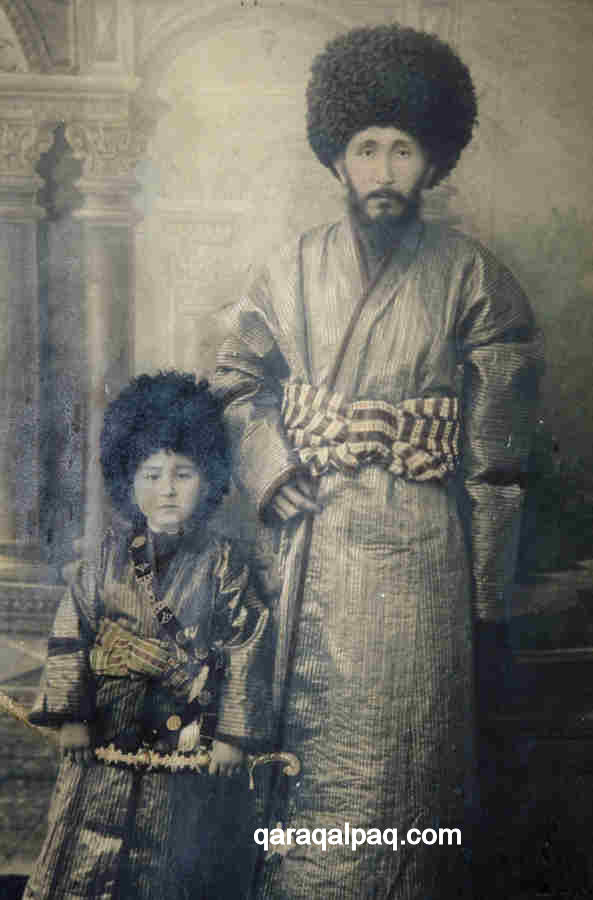
|
Isfandiyar Jurgi Bahadur Khan (1910-1918), the penultimate Khan of Khorezm, with his son.
A painting from the Museum in the Fortress Ark in the Ichan qala, Khiva.
The Tsar's abdication caught Isfandiyar Khan by surprise while he was spending the winter in the Crimea and he was escorted back to Khiva by a detachment
of Russian troops. Meanwhile the Khivan Jadidists, who were all Uzbeks and numbered less than fifty, had allied themselves with the soviet formed by the
Russian garrison in Khiva. They persuaded the Khan to issue a manifesto of reforms, just as the Emir of Bukhara had done a few weeks earlier. The
manifesto was actually composed by the Jadidist leader, Husayn Beg Matmuradov, and promised a constitutionally elected government, civil liberties, a
judiciary, and improvements to the schools, railways, and the post and telegraph service. A Khivan Majlis was then assembled, consisting of
thirty beys from each region of Khorezm but excluding any representatives of the Turkmen population, and Matmuradov was duly elected Prime
Minister. It was only later, following pleas from the local Russian commander, that seven Turkmen chieftains were subsequently invited to join the
Majlis.
This concession failed to satisfy the troublesome Yomuts and by May they were back again, pillaging local Uzbek villages. In June a delegation of
Jadidists travelled to Tashkent to request military assistance to put down the rebellion. The Turkmen raids continued into July and a troop of Orenburg
Cossacks was finally ordered to intervene under the command of Colonel Zaitsev, who was appointed acting military commissar of Khiva. Zaitsev's forces
did not reach the Khanate until early September and only then began to conduct raids against the Yomut insurgents. Within a week or two Junaid Khan
returned from exile in Afghanistan and offered his services to Colonel Zaitsev to fight against the rival chieftains who were now in control of the
Yomut rebels. Despite this surprising alliance Zaitsev made little impact on the uprising, mainly because of the increasing insubordination of his
troops. They were increasingly coming under the influence of the local Russian garrison, which had been organized as a soldier's soviet and was becoming
progressively disobedient towards its officers.
While the delegation of Jadidists were in Tashkent Isfandiyar's hakims persuaded the Khan to stage a coup dࢹtat and to arrest
Matmuradov and his Jadidist associates. With the Khan firmly back in control of Khorezm and the Turkmen running riot, the Turkestan Committee came to
the conclusion that the Khanate was incapable of political and social modernization on its own. They decided to revert to Kuropatkin's idea of
introducing reform under military supervision with the installation of a Western-style constitutional monarchy. This would leave the Khan as the head
of state alongside an elected government, who would be responsible for the introduction of a package of comprehensive reforms. A Russian military
commissar with extensive powers would oversee the required changes.
The authority to introduce these important and long overdue reforms was finally sought from Petrograd in mid-September, with a recommendation that they
should be approved by October. But the proposals became bogged down within the Russian bureaucracy. The decision had still not been made when the
Provisional Government was overthrown in November. Time had run out. Khiva was no longer facing mild reform - it was looking at total revolution.
References
Abbott, J., Narrative of a Journey from Heraut to Khiva, Moscow and Saint Petersburg, William H. Allen and Co., London, 1843.
Becker, S., Russia's Protectorates in Central Asia: Bukhara and Khiva, 1865 1924, Harvard University Press, Cambridge, Massachusetts,
1968.
Burnaby, F. G., A Ride to Khiva, Oxford University Press, Oxford, 1997.
Christie, E., Through Khiva to Golden Samarkand, J. B. Lippincott Company, Philadelphia, 1925.
Curtis, W. E., The Revolution in Russia, National Geographic Magazine, pages 302 to 316, May, 1907.
Evans, J. L., Mission of N. P. Ignat'ev to Khiva and Bukhara in 1858, Oriental Research Partners, Newtonville, MA, 1984.
Hopkirk, P., The Great Game, Oxford University Press, Oxford, 1990.
Horne, C. F., ed., The Sacred Books and Early Literature of the East, Volume VI: Medieval Arabia, Parke, Austin and Lipscomb, New York, 1917.
Hughes, L., Russia in the Age of Peter the Great, Yale University Press, New Haven, 1998.
Kappeler, A., The Russian Empire: A Multiethnic History, Pearson Education, Harlow, 2001.
Karazin, N. N., In the Lower Reaches of the Amu, Vestnik Europy, Volume 2, pages 186 to 229, March 1875.
Karazin, N. N., In the Lower Reaches of the Amu, Vestnik Europy, Volume 2, pages 651 to 691, February 1875.
Kühlewein, E., Abridged Narrative of a Journey to Khiva, with Historical Particulars relating to the Khanat during the Government of Seid-Mohammed
Khan, 1856-1860, The Russians in Central Asia, translated by John and Robert Michell, pages 23 to 45, Edward Stanford, London, 1865.
Lansdell, H., Russian Central Asia, Houghton, Mifflin and Company, Boston, 1885.
Le Messurier, A., From London to Bukhara and a Ride through Persia, Richard Bentley and Son, London, 1889.
MacGahan, J. A., Campaigning on the Oxus and the Fall of Khiva, Harper and Brothers, New York, 1874.
Meyer, K. E., and Brysac, S. B., Tournament of Shadows. The Great Game and the Race for Empire in Central Asia, Counterpoint, Washington, 1999.
Naumkin, V. V., Khiva, Garnet Publishing, Reading, 1993.
Nurmukhamedov, M. K., Muminov, I. M., and Dosumov, Y. M., History of the Karakalpak ASSR, Volume 1, Fan Publishing House, Tashkent, 1986.
Olufsen, O., The Emir of Bukhara and his Country, Elibron Classics, facsimile of 1911 edition, 2002.
Pahlen, K. K., Mission to Turkestan, translated by N. J. Couriss, Oxford University Press, London, 1964.
Pierce, R. A., Russian Central Asia 1867-1917, University of California Press, Berkeley and Los Angeles, 1960.
Rich, V., Shevchenko's "Aral Sea" Poems A Selection, Ukrainian Review, Volume 46, number 1, pages 81 to 89, London, 1999.
Schuyler, E., Turkistan, Sampson Low, Marston, Searle and Rivington, London, 1876.
Vambery, A., Travels in Central Asia, Praeger Publishers, New York, 1970, reprint of the original edition published by John Murray, London, 1864.
Vambery, A., Sketches of Central Asia, W. H. Allen, London, 1868.
Vambery, A., Sketches of a Journey through Central Asia to Khiva, Bokhara and Samarkand, from The Country of the Turkomans, Oguz Press and Royal
Geographical Society, London, 1977.
Wheeler, G., The Modern History of Soviet Central Asia, Weidenfeld and Nicolson, London, 1964.
Wood, H., The Shores of Lake Aral, Smith, Elder & Co, London, 1876.
Return to top of page
Home Page
|
|







